The Seeds of Change 1600 - 1929









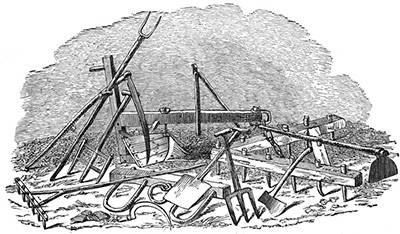




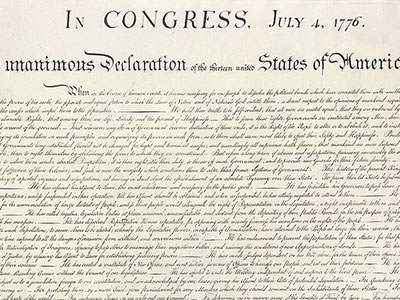









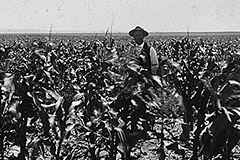

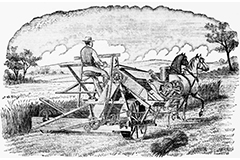

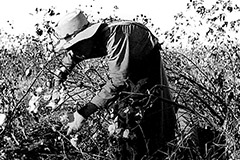



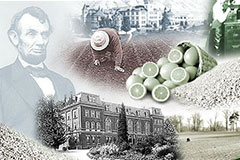


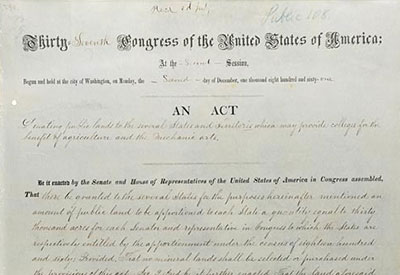

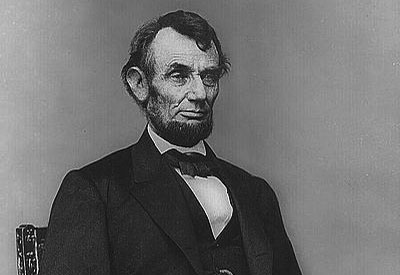

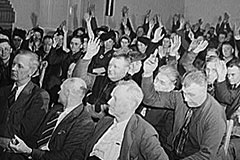

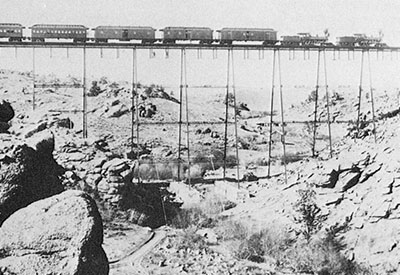



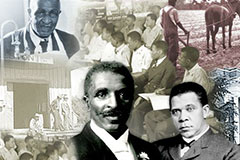


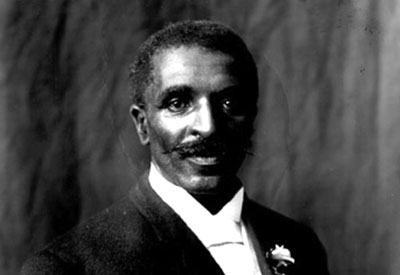





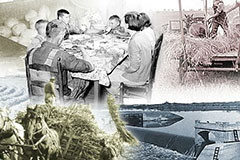




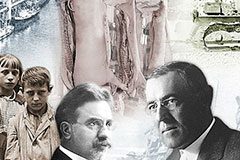




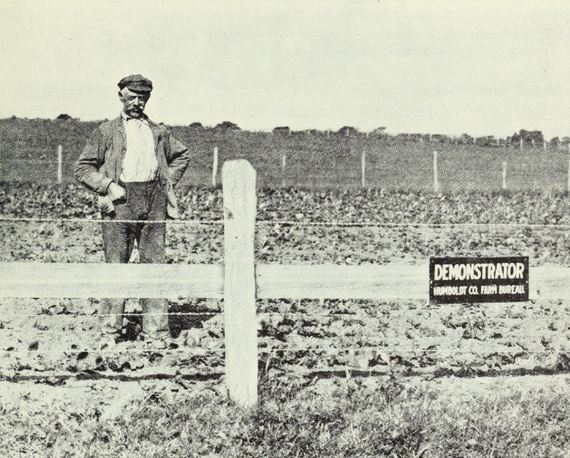

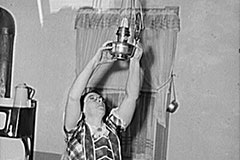

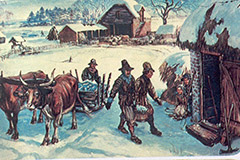





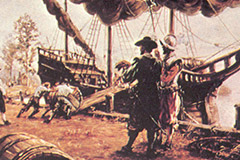

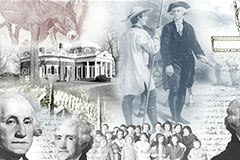


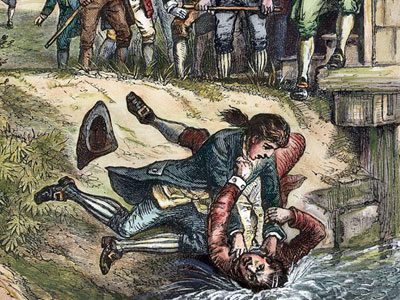

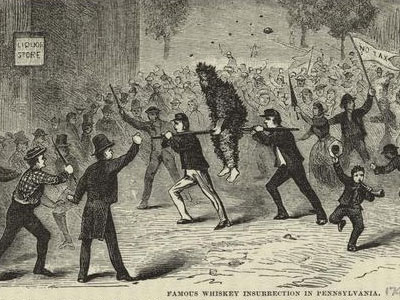



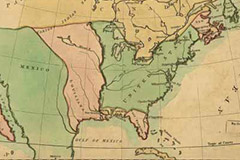

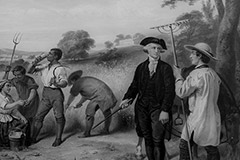

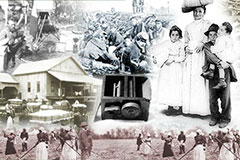




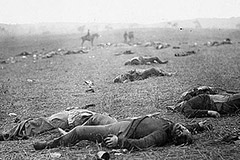

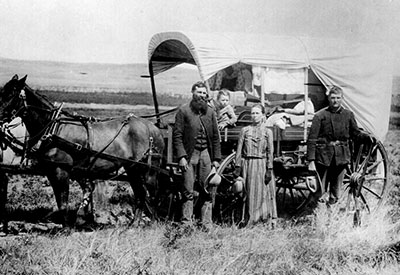



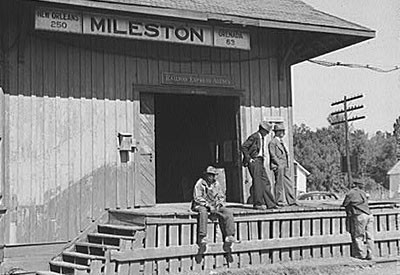

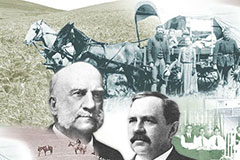


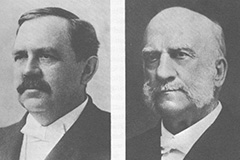

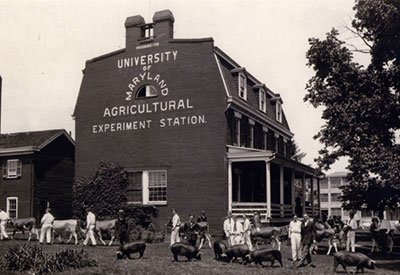



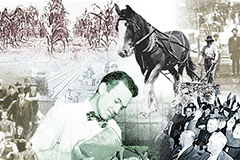




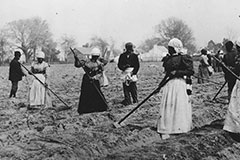





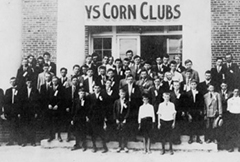









What would you like to find?

Downloadable Media: The Seeds of Change
Imagery



















Video

Panama Canal
Audio

























































Imagine you are on a journey to America, leaving behind everything you have known for untold dangers ahead. You are willing to take the risk because you want to start a new life where you will be free to work hard on your own land. The New World means a new life - a life of possiblities.
Across the Atlantic Ocean, in America, historic events are shaping an exciting way of life for common citizens of the United States. Vast, rich lands set the stage for people to make their dreams a reality. Their hard work earns them cash, free time, and a life beyond basic needs. Their system of government is the foundation for this prosperity; established through the good fortune of free, plentiful land and a century long experiment in democracy.
How did the practices of this new kind of government support a revolution in agricultural science, technology, and education? How did agriculture help the United States of America become a prosperous, thriving nation and major world power? Consider the answers to these questions as you enjoy "Growing a Nation: the Story of American Agriculture".
The first permanent English settlement was established at Jamestown, Virginia.

Jamestown Saved by Tobacco
Arriving on three ships, The Susan Constant, the Godspeed, and the Discovery, 104 men and boys arrived from England and named the settlement after their king, James I. The area was chosen because it was far enough inland and surrounded by water on three sides, which made it easily defensible against Spanish invaders, and was not currently inhabited by native Americans. A triangular fort was constructed by June 15 to protect the settlers from the local Powhatan Tribe, whose hunting grounds were located on the settlement area.
While the relationship between the settlers and the natives was tenuous, the Powhatans sent food to Jamestown Settlement when disease from drinking salt water and drought conditions devastated the population. During the winter of 1609-1610, known as the Starving Time, 80-90% of the settlers had perished due to disease and starvation. Help arrived in May 1610 with the arrival of Sir Thomas Gates, the new governor. Sir John Rolfe brought tobacco seeds with him to the colony in 1612, which turned the settlement into a profitable endeavor for the Virginia Company.
The Growth of the Tobacco Trade
Questions
Based on "The Growth of the Tobacco Trade":
What types of economic ventures did Jamestown settlers attempt? Why did they try these experiments?
Compare and contrast the views of Thomas Hariot and James I on the nature of tobacco.
What were the benefits and consequences of growing tobacco in the colony?
Stebbins, Sarah. "A Short History of Jamestown." National Park Service. 2011. Web. 27 July 2018.

Agriculture in Jamestown
All forms of domestic livestock, except turkeys, were imported at some time. Crops from the New World were adapted to English diets and lifestyles, and included maize, sweet potatoes, tomatoes, pumpkins, gourds, squashes, watermelons, beans, grapes, berries, pecans, black walnuts, peanuts, maple sugar, tobacco, and cotton.
In 1609, settlers mined bog iron ore near Jamestown, and by 1619, the first iron production facility in North America, Falling Creek Ironworks, was established along the James River. However, due to native attacks in 1622, the facility did not last long.
Take the link to view an artifact found at the Historic Jamestowne archaeological site:
Questions
What was the emphasis at Jamestown during its first few years, rather than cultivating food?
Is there a relationship between the crops grown and the Falling Creek Ironworks? Explain. How might this relate to farming today?
"Agricultural Fields." Jamestown-Yorktown Foundation, Inc. 2011. Web 31 July 2018.
In 1619, the first African slaves were brought to Virginia from Angola in West Central Africa; by 1700, slaves were displacing southern indentured servants. For additional information about indentured servants in Colonial Virginia, and the transition to slavery use the links below.

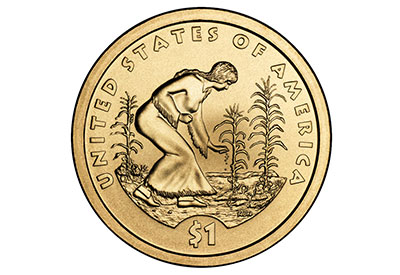
Three Sisters Gardening
Corn, beans, and squash were some of the staple foods of Native American cultures. These crops were known as the "three sisters" because they were commonly planted together as companion crops: each benefits the others as they grow. Utilize the resource below to learn more about who the "three sisters" are, their importance, and when and how to plant them.
Questions
How did these plants benefit each other?
What principles could farmers and scientists learn from this agricultural technique that could be used in growing other crops?

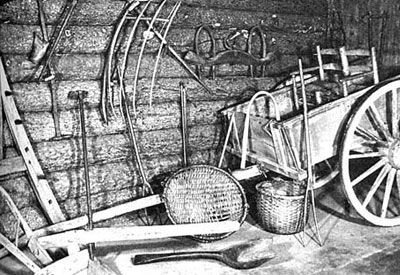
Early Farm Implements
Questions
Looking at this equipment, what agricultural products would you guess this farmer raised?
Do you think these tools belonged to a poor farmer or a wealthy farmer? Why?
In what ways, if any, would these tools be labor-saving devices?
How do you think this farmer obtained these tools?

Native American Agriculture
Contrary to what many people believe today, the land the first Europeans saw in America did not consist entirely of untouched land and pristine forests. Read this excerpted account of the history of agriculture in southeastern America before the arrival of Europeans.
For a minimum of 12,000 years, Native Americans (or Indians as was the European term for Native Americans) had been skillfully manipulating the environment, primarily with fire. The landscapes that the first Europeans encountered were not undisturbed, dense forests as many people today envision. Knowledgeable humans skillfully modified the landscapes to support a population numbering in the millions.
The cultivation of the tropical maize, flint corn, and beans along the Mississippi River and in the Gulf States marks the beginning of the Mississippian culture.... The adopted intensive agricultural practices from Mesoamerica influenced the landscape in the Southeast dramatically. Large native populations developed in much of the lower South because the more sophisticated agricultural system produced more food. Without draft animals or plows, agriculture with stone or wood implements was limited to the tillable soils of floodplains, where spring flooding helped renew soil fertility. Agricultural fields were cleared first by girdling trees and then burning the area. The ashes acted as fertilizer. Stumps were also removed over time and in the spring old agricultural debris was burned off before planting. When soil fertility declined from cultivation, fields lay fallow but were burned annually to maintain their open condition for future agricultural use. Most of the cultivatable floodplains of the Southeast were cleared of forest and managed in this way.
During the period of European contact, disease-related mortality rose to levels previously unknown; and the impact of these diseases was swift and harsh. In areas of the Caribbean, entire native populations were erased. These epidemic diseases were transported from the Caribbean to Mexico and Central America and may have preceded the arrival of the Spanish in these areas. Epidemic diseases were introduced to the natives of the Southeast at about the same time. During the 100 years of Spanish exploration, disease decimated the dominant Mississippian cultures of the Southeast and resulted in their collapse by 1600.
European diseases not only depopulated Native Americans and their culture (depopulation is estimated as high as 90 to 95 percent), they disrupted the social structure of native societies. As in all epidemics, mortality was disproportionably greater among the young and old. Loss of the younger generation had profound effects on the integrity of American Indian societies. The loss of manpower created difficulties maintaining agricultural systems and fire regimes. Loss of the elderly eliminated a storehouse of knowledge, tradition, and custom.
The arrival of the English continued the epidemic diseases and decimation of American Indians for at least another century. English trade with the natives lured them into dependence on the European fur market for European goods, which in turn diminished the traditional reasons for hunting, while devastating wildlife populations. As the fire regimes and agricultural systems gradually eroded, the appearance of the land began to change. Uncontrolled vegetation began to form an unbroken shroud. The extensive canelands witnessed by English settlers as they pushed inland were signs that the thousands-of-years-old fire ecosystems created by the natives were in decline."
Questions
What were the agriculture practices in the Americas before European settlers arrived?
How and why did Native American agriculture change after Europeans arrived?
Wayne D. Carroll, Peter R. Kapeluck, Richard A. Harper, and David H. Van Lear, "Background Paper: Historical Overview of the Southern Forest Landscape and Associated Resources," Final Report Technical, Southern Forest Resource Assessment [online].

Sheep and Wool
Wool played an important role in colonial America. Before the Revolutionary War, most of the finest textiles and fashionable styles were imported from Great Britain. Many colonists wanted to produce their own clothing and textile goods. Wool and linen were the most common materials used. Homespun clothes, clothes that were produced by the colonists, reduced the amount of clothing that had to be bought from England.
In 1699, under the rule of King William III, the British Parliament issued the Wool Act which prohibited American colonists from exporting wool or wool products outside of the colony in which it was produced. The king banned the export of sheep to the American colonies in an effort to protect England’s wool industry. Wool could only be imported into the colonies by Great Britain. The Wool Act was one of a series of taxes that divided Great Britain and its colonies in America.
The colonists began protesting the Wool Act by refusing to purchase or wear English textiles. Many colonists refused to purchase English goods. It became a patriotic act to wear American homespun clothing. George Washington, Thomas Jefferson, and Benjamin Franklin are notable figures who wore homespun clothing as a patriotic statement of their devotion to American independence and freedom. In the American colonies, spinning and weaving wool became a necessity and a patriotic duty.
In colonial times, the process of making wool cloth began with shearing sheep in early spring with hand clippers. The wool was cleaned through a process called scouring in which the wool underwent a series of baths before it was laid out to dry.
Wool grease is produced as part of the wool’s growth and helps protect the sheep’s wool and skin from the environment. Scouring removes this grease from the wool. The grease can be captured from the scouring water. When it is refined, this grease is known as lanolin. Lanolin can be used in moisturizers, cosmetics, medicine, and industrial applications.
In preparation for spinning, wool must be carded. The colonists used hand carders to comb the wool, remove debris, and untangle the fibers, aligning them parallel with each other. Colonists used dye formulas that included insects, roots, flowers, nuts, seeds, tree bark, leaves, or berries. Because of the toxic chemistry, many of these colonial dyes have been deemed unsafe in our modern era. The dyeing process involved soaking wool in kettles of dye over fires for several hours.
Wool was spun into thread or yarn by tightly twisting the fibers using a spinning wheel. Weavers turned the wool thread into cloth using looms. Wool was also felted, a process of matting fibers together, to make products such as hats and slippers.
Questions
How much time do you think it would have taken make a felted wool coat or spin yarn for a sweater?
How many articles of clothing might a colonial have?
Lynn Wallin, National Center for Agricultural Literacy
During the early 1700s agricultural technology consisted of the following: oxen and horses for power, crude wooden plows, all sowing by hand, cultivating by hoe, hay and grain cutting with a sickle (one-handed tool with short handle and curved blade), and threshing with a flail (a tool made with two long sticks attached by a strip of leather). As the century came to a close farming technology had advanced from hand tools to farming equipment that used horses and steam power. These innovations along with indentured servant labor (in the north) and African slaves (in the south) increased farm productivity.

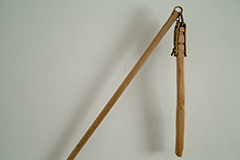
Flail
A flail is an agricultural tool that was used for threshing grain, the removal of the husks from the grain. It consisted of two pieces of wood, one longer, the other shorter, and was attached by a piece of rope, leather, or small chain. The grain would be "beaten" or threshed with the flail, which allowed a person to be able to thresh about seven bushes of grain a day. The flail was replaced by the thresher in the mid-19th Century, with the growth of industrialization.
Questions
Why was the flail an ancient Egyptian symbol?
What is the value of using a flail over a different method for removing grain from its husks?
"Flail". Encyclopaedia Britannica. 2018. Web. 7 August 2018.

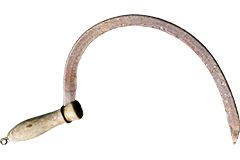
Sickle
The sickle, an agricultural implement that has a curved blade with a short handle, was used as early as the Iron Age, and continues to be one of the most widely used around the globe. While using a sickle to reap grain or cut hay is slow and tedious, it is inexpensive.
Questions
Why was the sickle a part of the symbol from the former Soviet Union?
What advantages does using a sickle have for farmers around the world?
"Sickle". Encyclopaedia Britannica. 2018. Web. 7 August 2018.

Jeffersons' Plow
In addition to being a philosopher, statesman, and scientist, Thomas Jefferson was also an inventor, always looking for ways to improve his farm.
Visit the Thomas Jefferson Monticello website to learn about one of his inventions in 1794 the "Mouldboard Plow of Least Resistance."
Questions
Why did Thomas Jefferson design this new plow for his home in Monticello?
Why was Thomas Jefferson successful in so many areas of his life?
Why was he so passionate about agriculture and improving farming?

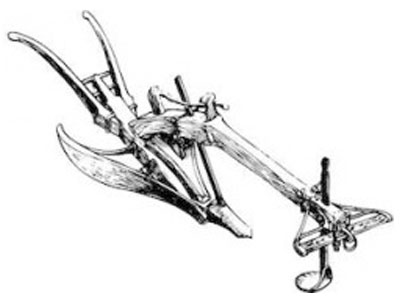
First Cast-Iron Plow Patent
Charles Newbold, of Burlington County, NJ, patented the first cast-iron plow in 1797. Newbold ran into a couple of issues getting farmers to use his plow, 1) farmers were afraid that the iron would poison the soil and 2) farmers that used the plow complained the metal wore down quickly and was brittle.
Questions
How would the invention of a reliable plow increase farm production?
Tobacco was the important money crop, and almost every ship that sailed from a plantation wharf carried hogsheads of the ‘delightful weed’ in its hold. Many other commodities too, were shipped to the mother country as well as to New England, the middle colonies, Barbados, Madeira, Bermuda, and Jamaica.

Colonial Agriculture & Trade
Colonial Williamsburg maintains a website describing life and society during colonial times. Explore their 18th Century Trades Sampler page to learn about trade practices of the time.
Questions
What was one of the most important crops in colonial Virginia?
How much labor did it require to produce this key southern crop for export?
What resources did southern planters have for producing this crop?
If many of the crops grown in the southern part of America required large numbers of workers, how would southern farmers react to changes that affected their labor supply?

Agriculture in Virginia
Read the excerpt below regarding trade and the English colony of Virginia in 1732.
“Tobacco was the important money crop, and almost every ship that sailed from a plantation wharf carried hogsheads of the ‘delightful weed’ in its hold. Many other commodities too, were shipped to the mother country as well as to New England, the middle colonies, Barbados, Madeira, Bermuda, and Jamaica. Exports from one Virginia shipping district -- Porth South Potomac -- in 1732 included (besides tobacco) staves, timber, corn, wheat, peas, beans, masts, pig iron, feathers, pork, cotton, earthernware ‘parcels,’ woodenware ‘parcels,’ bacon, hides, deerskins, beaver skins, oak and walnut logs, cider and cider casks, beef, wine pipes, snakeroot, tallow, pewter and brass ‘parcels,’ and copper ore casks. Items imported included rum, salt, Irish linen, fish, chocolate, molasses, sugar, earthernware, ‘woodware,’ millstones, Madeira wine, cheese, rice, ironware, and ‘parcels from Great Britain.’ The latter ‘parcels’ included furniture fabrics, rugs, pottery and porcelain, silver, pewter, copper and brassware, and other household furnishings and accessories needed by the colonists.”
Questions
What agricultural products did the people of Virginia export?
Which agricultural products might they have had to import, and why?
From the text excerpt, what can you determine about the importance of trade between the American colonies and England?

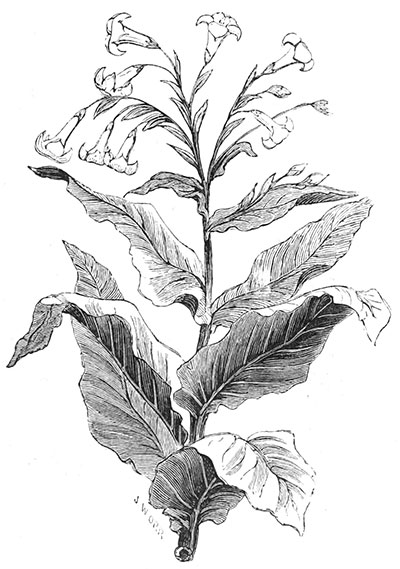
Tobacco Trade
While tobacco was the most significant cash crop in Virginia, like all agricultural products, it was dependent upon favorable weather conditions. In order to grow tobacco successfully, farmers needed a warm climate with rich, well-drained soil. In addition, tobacco tended to deplete the soil of its nutrients after three of four years of cultivation, so the need for crop rotation was essential.
According to historian Tony Williams, "The soil exhaustion that resulted from raising tobacco caused planters such as George Washington to diversify their plantations and switch production into growing grains. The port of Norfolk thus became a major exporter in the wheat and corn." (2009, p. 30)
Hurricane of Independence, by Williams, tells about a gentleman named Landon Carter who experimented with various crops. He took meteorological data on a daily basis in attempt to "master nature." However, he proved to be rather unsuccessful as he watched his crops die from early frosts, too much, or too little rain. Carter "confided to his diary that he had less control than he desired and that, 'The farmer is nothing without weather.' Weather was a matter of chance, and he was its pawn. The farmer had little choice but to 'always feel the weather and rejoice when it is good and be patient when it is unseasonable.'" (2009, p. 63)
Weather is certainly beyond human control, but there was more to raising tobacco than issues with the weather. Tony Williams explains, "Simply growing the crop was an extremely difficult task and one that often vexed the planters.
"The 'noxious, stinking weed,' as King James I called it, was unlike most other crops in that it demanded year-round labor and careful attention. After the twelve days of Christmas and the holiday from work for the slaves was over, the intensive planting began as tobacco seeds were sown with animal or ash manure and covered with branches to protect against frost. Because of the vulnerability of the plants, ten plants were planted for every one eventually cut.
In late spring, running slaves carried the seedlings to their fields and planted them during wet weather to avoid damaging their roots. Slaves worked all summer to weed the fields and fight against pests. The slaves then 'topped' the tobacco in order to prevent flowering, which would draw nutrients away from valuable leaves.
In September, during hurricane season, the slaves would cut the plants according to the planters' judgment. This was a critical decision because if the leaves were too moist, they would rot on the ships crossing the Atlantic. Conversely, cutting them when they were dry meant that they would become brittle and disintegrate.
The 'harvest' did not mean the end of the work for the slaves because the tobacco had to be cured in special curing barns to dry. If the weather were too rainy, special fires would be lit to prevent rot--hopefully without burning down the curing barn. Slaves then stripped the leaves from the stalks and hung them to dry before they were pressed and loaded into thousand-pound hogshead barrels for the trip to England or Scotland. The process generally was not completed before the next year's crop was laid." (Williams, 2009, p. 66)
Successful tobacco crops meant lucrative profits for planters, which promoted a boost for the global economy. Tobacco plantation owners now had the means to purchase goods from Europe.
Williams continues, "Planters were voracious consumers of luxury goods from Great Britain as they sought to emulate the lifestyles of fashionable Europeans. Great amounts of goods were conspicuously consumed to adorn their great houses. George Washington, for example, put in an order for sterling silver forks with ivory handles, pewter plates engraved with his crest, a carriage, and a fashionable summer cloak and hat for his wife Martha." (2009, p. 67)
Questions
Based on the excerpt from Tony Williams' book, Hurricane of Independence, why did tobacco planters need to diversify their plantations?
Who was Landon Carter, and what was his attitude about weather and farming?
Describe the process of the cultivation and harvest of tobacco.
What was the effect of successful tobacco crops on the world economy in the 1700s?
Williams, Tony. Hurricane of Independence. Naperville: Sourcebooks, Inc., 2009. Print.


The first European settlers in America quickly learned that they had to adapt or starve. During the winter of 1609 to 1610, two-thirds of the settlers in Jamestown, Virginia, the first permanent English settlement in America, died. Native Americans taught the survivors how to grow corn, pumpkin and squash. Corn and beans were planted together in small mounds so the bean vines could grow up along the cornstalks. The beans also added nitrogen to the soil. Pumpkins and other kinds of squash were planted between the mounds. Seeds were saved for the next year's crop. Another Native-grown plant, tobacco, became the primary cash crop of colonial America. Eventually, through trial and error, the settlers were also able to adapt European crops to the New World.
As the English gained control of America, their merchants sought new markets for colony crops. However, the British government imposed heavy duties on many agricultural products from the colonies and limited the export of more valuable products like tobacco, indigo, wheat and livestock. These restrictions created resentment among the Colonists and were a major cause of the American Revolution.
During the seventeenth and eighteenth centuries, England adopted a series of laws known as “Parliamentary Acts.” These laws regulated trade from the American colonies by requiring that goods exported to England be sent on British ships.

Parliamentary Acts
During the seventeenth and eighteenth centuries, England adopted a series of laws known as “Parliamentary Acts.” These laws regulated trade from the American colonies by requiring that goods exported to England be sent on British ships. One section of these laws, the Navigation Acts, required that the colonies transport their most expensive products back to England and pay costly import taxes for this right. The Navigation Acts also restricted other exports from the colonies. Although these laws had been in effect for many years, they were not strictly enforced. Beginning in 1764, however, the British passed additional acts that heavily taxed the colonies and eventually led to open rebellion.
Questions
How might these various acts affect agricultural trade?
What did the colonists mean when they claimed they had “taxation without representation”?
The Declaration of Independence resulted partly from British controls on farm exports, restrictions on land titles, and limitations on western settlement.
According to scholar Staughton Lynd and Temple University historian David Waldstreicher, the seeds of the American Revolution were sown by economic issues: "From the mid-18th century right up to the signing of the Declaration, Americans objected to a myriad of British imperial policies principally on economic grounds. The antitax sentiment of the Boston Tea Party in 1773 is well known, but Americans also protested British attempts to requisition resources during the Seven Years War (175663), imperial currency manipulation that left the colonies strapped, and prohibitions on trade with the French West Indies, along with many other policies."
Lynd, Staughton and Waldstreicher, David. "Free Trade, Sovereignty, and Slavery: Toward an Economic Interpretation of American Independence." William and Mary Quarterly. October 2011. Web. 27 July 2018.


Many of the leaders of the American Revolution, including George Washington and Thomas Jefferson, were farmers. Both Washington and Jefferson were interested in experimenting with agriculture. At this Mount Vernon, Virginia farm, George Washington experimented with crop rotation and with new seeds and plants. He also became the Nation's first mule breeder, using animals given to him by the king of Spain.
Thomas Jefferson also enjoyed experimenting with agriculture on his Virginia estate at Monticello. Both Washington and Jefferson helped organize societies for improving agriculture. These societies were pioneers in agricultural science and education. Some societies issued reports, published journals, and sponsored agricultural fairs to encourage agricultural improvement.
Early Americans were self-sufficient; ninety-three percent of them were farmers, and free land, rich soil, and a temperate climate helped them do well. Farmers began to use horsepower to pull newly invented farm implements like the broadcast seeder and the mechanized grain reaper. These implements improved working conditions for farmers and provided more cash so that they could enjoy a better standard of living. Immigrants came to America in droves, exchanging their own indentured labor for passage to seemingly limitless American freedom, land, and opportunity.
In March 1765, British Parliament passed the Stamp Act, the first direct tax on the American colonies, which included taxation on printed documents, newspapers, dice, and playing cards.
In July 1765, the Sons of Liberty organized their underground operation to boycott British goods in protest of the Stamp Act.
In October 1765, the Stamp Act Congress convened in New York City to prepare a resolution to King George III and Parliament, asking for the repeal of the Stamp Act and the Acts of 1764.
In December 1765, over 200 Boston merchants joined in boycotting British imported goods, which helped further the boycott movement.
Shay's Rebellion, a farmers' revolt against high taxes and deflation in western Massachusetts, demonstrated the general resentment from the economic crisis that followed the American Revolution.
In 1791, the First National Bank was chartered and signed by George Washington. Its purpose was to manage the massive Revolutionary War debt and create a standard currency for the nation.

In 1790, the total U.S. population was 3,929,214; farmers made up 90% of the labor force.
On July 31, 1790 Samuel Hopkins was issued the first patent for a process of making potash, an ingredient used in fertilizer. The patent was signed by President George Washington. Hopkins was born in Vermont, but was living in Philadelphia, Pa. when the patent was granted. Potash, or potassium, is the third major plant and crop nutrient after nitrogen and phosphorus. It has been used since antiquity as a soil fertilizer (about 90% of current use). Consider how the easy availability of this element would impact agriculture production.
The Whiskey Rebellion, a farmers' revolt against taxes on grain in whiskey, began in 1791 when the federal government authorized its first tax on a domestic product in order to reduce the national debt. In 1794, opposition among farmers and distillers in western Pennsylvania grew to the point where George Washington dispatched troops to quell the rebellion.
The Public Land Act authorized federal land sales to the public in minimum 640-acre plots at $2 per acre in an attempt to encourage the settlement of western lands. Unfortunately, the majority of those who purchased these lands tended to be speculators, rather than settlers.

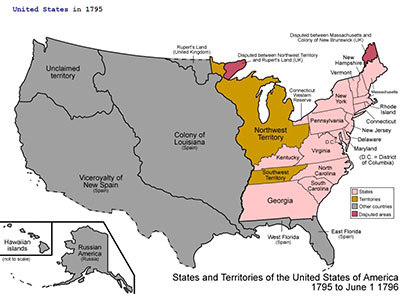
Western Lands and Territories
Until 1776, the much of the land west of the Mississippi River was owned by Spain. The Public Land Act opened uncontested "western lands and territories" to those who would settle and expand the United States in these outlying areas. To learn more about the Public Land Act and the influence of subsequent land acts including what is meant by "squatters rights" (a term you may have heard) “cabin rights,” “corn rights,” or “tommyhawk rights,” read a brief post from World History on The Later Land Acts, 1796-1862.
Questions
As a settler, what would you be looking for in terms of land and resources necessary to survive?
New technologies on the farm and in transportation result in growing agricultural exports. The railroad era begins with Peter Cooper's railroad steam engine, the Tom Thumb, running 13 miles in 1830. By 1860, nearly 30,000 miles of railroad had been constructed.

Exports 1800-1850s
From 1800-1809, the average annual value of agricultural exports totaled $23 million or 75% of total exports.
From 1810-1819, the average annual value of agricultural exports totaled $40 million/year or 87% of total exports.
From 1820-1829, the average annual value of agricultural exports totaled $42 million/year or 65% of total exports.
From 1830-1839, the average annual value of agricultural exports totaled $74 million/year or 73% of total exports.
From 1840-1849, the average annual value of agricultural exports totaled $90 million/year or 65% of total exports.
From 1850-1859, the average annual value of agricultural exports totaled $189 million/year or 81% of total exports.
Questions
What historical event(s) or underlying factors can be used to make sense of the data?
Why is this data relevant?
What is one important idea you have learned from this information?

Farm Labor Comparisons
In 1830, about 250-300 labor-hours were required to produce 100 bushels (5 acres) of wheat with a walking plow, brush harrow, hand broadcast of seed (scattering of seeds by hand), sickle, and flail.
In 1850, it took about 75-90 labor-hours to produce 100 bushels (2 1/2 acres) of corn with a walking plow, harrow, and hand planting.
In 1840, the average total U.S. population was 17,069,453, and farmers made up 69% of the labor force.
In the 1850s, the U.S. population was 23,191,786, and farmers made up 64% of the labor force. During this time there were 1,449,000 farms and the average farm size was 203 acres. It took about 75-90 labor-hours required to produce 100 bushels (2 ½ acres) of corn with walking plow, harrow, and hand planting.
As the U.S. population grows the farm population shrinks. How do fewer farmers continue to feed a growing population?
President Thomas Jefferson acquired the Louisiana Territory by purchasing it from France in 1803 for $15 million dollars, an average of four cents per acre. With this purchase, the geographical size of the United States doubled and opened the west for expansion.

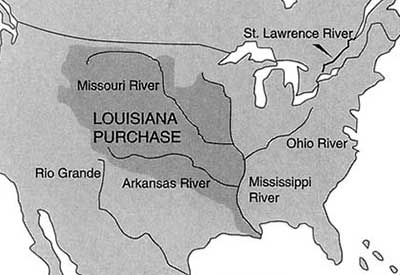
Doubling the Size of the United States
President Thomas Jefferson acquired the Louisiana Territory by purchasing it from France in 1803. With this purchase, the geographical size of the United States doubled.
Questions
Why would this large addition to the territory of the United States excite farmers, ranchers, and immigrants?
How do you think the Indian tribes living in this region may have felt about their land being owned by the United States? Why?
What challenges did families who wanted to establish farms or ranches in this new territory face?
What challenges would the acquisition of such a large area of land pose to a young democratic government?
A plantation was a landholding large enough to be distinguished from the family farm, generally over 250 acres with a distinct division of labor (slaves) and management, with the latter primarily handled by the owner but often administered through an overseer. On a plantation you would find specialized production, usually with one or two cash crops. In contrast, Southern farms were smaller parcels of land that were generally run at the subsistence level by families. Farmers grew a greater variety of crops than did most planters, and they consumed much of their harvests themselves. They also depended on smaller labor forces--generally family members and in some cases a few slaves. In contrast to a plantation, a farm was typically administered by the owner without an overseer, thereby blurring the delineation between management and physical labor.
Prunty, M. (1955). The renaissance of the southern plantation. Geographical Review, 45(4), 459-491.

Differences Between Plantations and Farms
Great planters with very large holdings were a small minority among landowners. In 1860, only 2,300 planters (about five percent) owned 100 or more slaves. Thus the landscapes that they created were the exception rather than the rule in the antebellum South. Statistically, a significant percentage of slaves lived and worked on large plantations. Slaves living on plantations developed strong family alliances and ultimately forge a distinct culture. Use Wikipedia to see what others say about the differences between a farm and plantation and answer the following questions.
Questions
What were the differences between plantations and farms?
What is different about the number of types of crops grown on each? Why?
Why were black family groups more stable on large plantations than on small farms?
What percentage of southern farmers owned plantations?


Plantation Agriculture
Plantation economies were profitable in the south because of longer growing seasons (almost year-round), fertile soil, and many waterways in the area that made transportation much easier. The economy of the South was based on maximizing yields on large plantations. There were hand tools and implements pulled by horses but no machines so to get crops planted and harvested required many laborers. Although the majority of white southerners did work their own farms, large plantation owners used slave labor to plant and harvest cash crops, such as rice, tobacco, cotton, sugarcane, and indigo. Cash crops were commodities that were grown in large quantities and provided wide profit margins to the plantation owner. Profit, being the overall goal, required the use of cheap labor, and slavery kept the costs down. Using both slave men and women doing grueling work for eighteen hours a day, owners were able to create a labor force with little cost, since successive generations born on the plantations would automatically increase the number of laborers. Depending on location and the market plantation owners grew rice, sugar, tobacco, and later cotton.
The early English and European colonists had no experience in cultivating rice; however, examples of rice cultivation were available from African slaves, who did have knowledge on the subject. Construction of rice fields was a daunting task. Dirt walls, or banks, had to be created to keep out salt water, while ditches and gate were built to move fresh water in. In places like Delaware, 30,000 acres of swampland needed to be cleared before even attempting to construct rice fields. Rice seedlings were spread over and trampled into the soil by the feet of female slaves. The rice fields had to be flooded and drained, after which slaves acted as scarecrows to shoo away the birds. The rice was flailed (beaten), the hulls were removed, and the rice was polished before exporting. Rice was the major cash crop in Georgia and South Carolina by the 1690s. Rice gained popularity and quickly spread to other southern colonies, becoming one of the top ten exports during Colonial America.
Sugarcane, a tall, tropical grass, was first imported to the US from the West Indies; then grown in the south after the Louisiana Purchase in 1803. Best grown on rich flat land, sugarcane grows from 4 to 12 feet tall with a diameter up to 2 inches. Construction of sugarcane fields required 12-inch rows with seeds planted by hand at 36-inch intervals. When harvesting, the cane is cut toward the bottom of the stalk, leaving a portion to regrow for up to four times before having to be replanted. Slaves on sugar plantations, including women, men, and children, were responsible for planting 5,000-8,000 seeds that would produce one acre of sugarcane. Not only was sugar essential to England for tea, sugarcane was used to produce molasses, a major ingredient in rum, which was a key part of the Triangular Trade.
By the early 1790s, the use of slaves began to decline. Because Europeans could purchase rice and tobacco more cheaply from other British colonies, they refused to pay higher prices from the American colonies. In addition, cotton growers were struggling with making a profit because of the difficulty and time-consuming method of removing the seeds from the fiber. However, Eli Whitney’s invention of the cotton gin in 1794 changed the economy of the South. With the use of a cotton gin, a single laborer could clean the amount of cotton bolls as 50 slaves working by hand. By 1860, cotton sales earned more money than all other US exports combined. Cotton had become king.
Questions
How important were sugar, rice, and cotton to the southern United States?
What kind of labor was required to farm these crops?
How would the abolition of slavery after the Civil War affect the production of these crops in the South?
What are some of the major crops grown in your state today?
How much labor is required to produce these crops, and who provides the labor?
Trans-Atlantic Slave Trade Database from Emory University
Many of the leaders of the American Revolution, including George Washington and Thomas Jefferson, were farmers. Both Washington and Jefferson were interested in experimenting with agriculture.

The First Mule Breeder
At his Mount Vernon, Virginia farm, George Washington experimented with crop rotation and with new seeds and plants. He also became the Nations first mule breeder, using animals given to him by Charles III, the king of Spain in 1785. Of two donkeys sent across the Atlantic, "Royal Gift" was the only donkey to survive. Being better draft animals than horses and requiring less food, mules are a cross between a male donkey and a female horse. Washington believed that mules would revolutionize farming.
To learn more about different types of animals on Washington's farm, use the link below.
The Animals on George Washington's Farm
Questions
Why is Washington called "The Father of the American Mule"?
Other than mules, what types of animals were found on George Washington's farm?
Which animals do you think were most significant in helping Mount Vernon become a successful farm?
Bakmas, Johanna. "Royal Gift (Donkey)." Mount Vernon Ladies' Association. 2018. Web. 27 July 2018.

George Washington
George Washington served America in many roles, including first U.S. President, Commander in Chief of the Revolutionary Army, and farmer. Visit the Mount Vernon website to read about George Washingtons contributions to agriculture.
See Washington's contributions
Questions
Why do you think George Washington was so passionate about the land?
Does it surprise you that the President of the United States was a farmer? Why or why not?

Thomas Jefferson's Experiments
Thomas Jefferson also enjoyed experimenting with agriculture on his Virginia estate at Monticello. Both Washington and Jefferson helped organize societies for improving agriculture.
Jefferson grew 330 varieties of vegetables in his 1,000-foot-long garden terrace at Monticello, along with 170 fruit varieties. The south-facing terrace garden created a micro-climate, in which summer heat was capture and the cold winter was tempered.
Jefferson obtained new vegetable varieties from foreign dignitaries, and handed out vegetable seeds from these plants to his friends, family, and fellow politicians. Highly valuing diverse plants, he equated the introduction of an olive tree and upland rice into the United States to his writing of the Declaration of Independence.
During his service as an ambassador to France, Thomas Jefferson recognized that European plows were insufficient. In 1788, he redesigned the moldboard of the plow, the part that lifts up and turns over the soil. Monticello plows were used as early as 1794. Originally made of wood, Jefferson had the moldboard replaced with iron in 1814.
As president, Jefferson promoted the idea of commercial market gardening. He kept records of the introduction of thirty-seven vegetables at Washington, DC market gardens, and gave gardeners samples of new vegetables he obtained. In addition, Jefferson advocated the use of manure to remedy deficits in the soil, which is widely used today.
Questions
What was the significance of the Monticello plow?
Why do you think Jefferson is referred to as an innovator, rather than an inventor?
Regarding agriculture, what is Jefferson's greatest legacy?
Hatch, Peter. "Thomas Jefferson's Legacy in Gardening and Food." Thomas Jefferson Foundation, Inc. 2010. Web. 27 July 2018.

Useful Plants
Thomas Jefferson, the third President of the United States said, "The greatest service which can be rendered any country is to add a useful plant to its culture."
Questions
Why do you think Thomas Jefferson made such a bold statement?
Farmers began to use horsepower to pull newly invented farm implements like the broadcast seeder and the mechanized grain reaper. These implements improved working conditions for farmers and provided more cash so that they could enjoy a better standard of living.

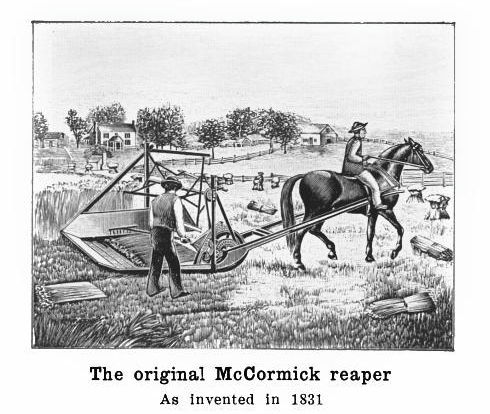
Horse-drawn Reaper
Cyrus McCormick, sometimes referred to as the Father of Modern Agriculture, made one of the most significant contributions to the success of U.S. agriculture by inventing the horse-drawn reaper in 1831. Read McCormick's biography on the Massachusetts Institute of Technology website to learn more about this remarkable man and his invention.
Questions
Why is Cyrus McCormick called the Father of Modern Agriculture?
Why was his invention so important to the success of U.S. agriculture?

Horsepower - A Unit of Power
One horsepower was originally defined as the amount of power required to lift 33,000 pounds one foot in one minute, or 550 foot-pounds per second or 745.7 watts. The term was adopted in the late 18th century by Scottish engineer James Watt to compare the output of steam engines with the power of draft horses. Watt (born in 1736) established the value for horsepower after he determined the strength of the average horse.
Questions
In what other contexts have you heard the term horsepower?
Besides agriculture, what have horses been used for?


By the 1800s the Northern states began to industrialize and export manufactured goods. With room to grow and resources to spare the United States government invested in exploration, opening new territories to farmers and ranchers. Technology was employed to develop transportation systems that brought produce and people together in a national market system. As the Northern states industrialized they attracted new immigrants, while the South's population stagnated. In 1800 half of all Americans lived in the South, but by 1850 only one-third of the population was there.
The Southern economy relied on producing and exporting cotton, sugar, rice, tobacco and wheat. The South also depended heavily on food imported from the upper-Mississippi valley. Production of work-intensive cash crops like cotton and tobacco expanded and the Southern economy became increasingly dependent on slave labor to keep the price of its crops competitive. Technological improvements like Eli Whitney's cotton gin also helped increase cotton production. This more efficient method for "ginning" or removing seeds from the cotton bolls with a machine, not by hand (which was done by slaves), lowered the cost of the processing cotton into thread. However, this innovation did not reduce the need for slaves, rather plantation owners increased their number of slaves to grow more cotton.
The slave-dependent Southern agricultural system worked only for a time. From 1861 to 1865, Americans fought a chaotic Civil War. For the South the war was a struggle to preserve their economy and way of life; for the North it was a struggle to preserve the Union and end slavery. Before the war sixty percent of Americans farmed, but when the war began large numbers of farmers left to fight so their land went untended. When peace was finally declared, many of the South's farms lay in ruin.
By the 1800s the Northern states began to industrialize and export manufactured goods. As the Northern states industrialized they attracted new immigrants while the South’s population stagnated. In 1800 half of all Americans lived in the South, but by 1850 only one-third of the population was there.
The Southern economy relied on producing and exporting cotton, sugar, rice, tobacco and wheat. The South also depended heavily on food imported from the upper-Mississippi valley. Production of work intensive cash crops like cotton and tobacco expanded and the Southern economy became increasingly dependent on slave labor to keep the price of its crops competitive. Technological improvements like Eli Whitney’s cotton gin also helped increase cotton production and made slavery profitable.

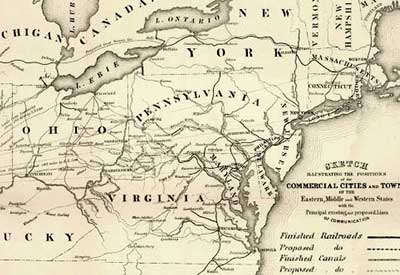
U.S. Transportation
This map of the United States, published about 1850, outlines all the major canals, railroads, and principal stage routes in the country.
Questions
What impact did these transportation systems have on the growth of the United States?
How could farmers and ranchers benefit from these transportation systems?
How did new transportation routes to the West affect the settlement of new American territories?
Why were there fewer transportation systems in the southern United States?
What did this difference mean for southern agriculture?
How have improvements in modern transportation affected agriculture today?

Southern Dependency
Although the South experienced prosperity for many years because of its cotton and tobacco plantations, it depended on the northern states for many of life's necessities. Henry Grady, editor of an Atlanta, Georgia newspaper, gave his account of a funeral he attended.
The grave was dug through solid marble, but the marble headstone came from Vermont. It was a pine wilderness but the pine coffin came from Cincinnati. An iron mountain overshadowed it but the coffin nails and screws and the shovel came from Pittsburgh. . . . A hickory grove grew nearby, but the pick and shovel handles came form New York. . . . That country, so rich in underdeveloped resources, furnished nothing for the funeral except the corpse and the hole in the ground.
Questions
How did this economic dependency contribute to the Civil War?
What part did this dependency play in ending the Civil War?
J. Jacobs, Cities and the Wealth of Nations (New York: Random House, 1984).

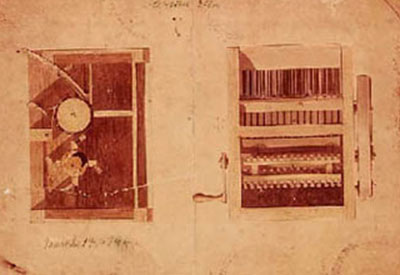
Cotton Gin
This is the drawing that Eli Whitney submitted to receive his patent for the cotton gin in 1794.
After the invention of the cotton gin, the yield of raw cotton doubled each decade after 1800. Demand was fueled by other cotton-related inventions of the Industrial Revolution, such as the machines to spin and weave it and the steamboat to transport it. By mid-century America was growing three-quarters of the worlds supply of cotton, most of it shipped to England or New England where it was manufactured into cloth. During this time tobacco fell in value, rice exports stayed steady at best, and sugar began to thrive, but only in Louisiana. At mid-century the South provided three-fifths of Americas exports--most of it in cotton.
However, like many inventors, Whitney (who died in 1825) could not have foreseen the ways his invention would change society for the worse. The most significant of these was the growth of slavery. While it was true that the cotton gin reduced the labor needed to remove seeds, it did not reduce the demand for slaves to grow and pick the cotton. In fact, the opposite occurred. Cotton growing became so profitable for the planters that it greatly increased their requirements for both land and slave labor.
Questions
What other agricultural inventions have had unintended positive and negative consequences in American history? Why?
Eli Whitneys Patent for the Cotton Gin, National Archives [online].

Slavery a Catalyst for Economic Power?
With the institution of slavery many Southern plantation owners had an economic advantage to inexpensively grow rice, sugar, tobacco, and later cotton. Listen to this Public Radio podcast interview of author Edward E. Baptist, historical scholar, on his book titled "The Half Has Never Been Told’ and respond to the following questions.
Questions
Would the U.S. have become a leading economic power without slavery?
How did the practice of slavery impact the growth of the United States?
From 1850-1870, the US experienced its first agricultural revolution. The development of improved and more efficient farm technologies, as well as the increase of railroad networks, led to domestic and foreign demand of goods.

Exports 1860-1920s
From 1860-1869, the average annual value of agricultural exports totaled $182 million/year or 75% of total exports.
From 1870-1879, the average annual value of agricultural exports totaled $453 million/year or 79% of total exports.
From 1880-1889, the average annual value of agricutural exports totaled $574 million/year or 76% of total exports.
From 1890-1899, the average annual value of agricultural exports totaled $703 million/year or 71% of total exports.
From 1900-1909, the average annual value of agricultural exports totaled $917 million/year or 58% of total exports.
From 1910-1919, the average annual value of agricultural exports totaled $1.9 billion/year or 45% of total exports.
From 1920-1929, the average annual value of agricultural exports totaled $1.94 billion/year or 42% of total exports.
Questions
How could you explain the drop in agricultural exports from 1860-1869? Why is this relevant?
How does the data reflect the economy of the nation?
In the 1860s the average total U.S. population: 31,443,321; farm population: 15,141,000 (est.); farmers 58% of labor force; Number of farms: 2,044,000; average acres: 199.
In the 1870s the average total U.S. population: 38,558,371; farm population: 18,373,000 (est.); farmers 53% of labor force; Number of farms: 2,660,000; average acres: 153
In the 1880s the average total U.S. population: 50,155,783; farm population: 22,981,000 (est.); farmers 49% of labor force; Number of farms: 4,009,000; average acres: 134
In the 1890s the average total U.S.population: 62,941,714; farm population: 29,414,000 (est.); farmers 43% of labor force; Number of farms: 4,565,000; average acres: 136. During this time it took 40-50 labor-hours to produce 100 bushels of wheat on 5 acres using a gang plow, seeder, harrow, binder, thresher, wagons, and horses; 35-40 labor-hours required to produce 100 bushels (2 1/2 acres) of corn with 2-bottom gang plow, disk and peg-tooth harrow, and 2-row planter.
In the 1900s the average total U.S. population: 75,994,266; farm population: 29,414,000 (est.); farmers 38% of labor force; Number of farms: 5,740,000; average acres: 147
In the 1910s the average total U.S. population: 91,972,266; farm population: 32,077,000 (est.); farmers 31% of labor force; Number of farms: 6,366,000; average acres: 138
In the 1920s the average total U.S. population: 105,710,620; farm population: 31,614,269p; farmers 27% of labor force; Number of farms: 6,454,000; average acres: 148
As the U.S. population grows the farm population shrinks. How do fewer farmers continue to feed a growing population?
Northern farmers produced a variety of crops and livestock, sometimes supplemented by craftwork. Southern plantation agriculture concentrated on export crops. For the South the war was a struggle to preserve their economy and way of life; for the North it was a struggle to preserve the Union, grow the economies of one nation, and end slavery. Before the war sixty percent of Americans farmed, but when the war began large numbers of farmers left to fight so their land went untended. When peace was finally declared, many of the South’s farms lay in ruin.

Labor Force
In 1860, farmers made up 58 percent of the labor force. It is estimated that during the Civil War over a million farmers left their fields to serve as soldiers.
During the Civil War, women took on the role of men in farming, running plantations, and spying. Some women even dressed up as men and served in the military.
For additional information about industry and economy during the Civil War, read the following:
Industry and Economy During the Civil War
Questions
What did the North and South do to make up for this critical loss of farm labor?
How would the loss of men working on farms and ranches have affected American society?
History of American Agriculture, 16072000, U.S. Department of Agriculture [online].

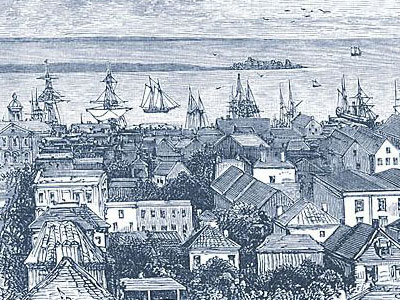
The Divide Between North and South
The Civil War began with the firing on Fort Sumter, South Carolina in 1861, and ended in Appomattox Courthouse, Virginia in 1865. Use the link below to learn more about the two distinct regions during this time period.
Questions
Compare and contrast agriculture in the North and the South. Discuss similarities and differences.
Who had the economic advantage during the Civil War? Explain.


In 1862, during the Civil War, President Abraham Lincoln created the United States Department of Agriculture, or USDA. The "people's department", as Lincoln called it, was created to "acquire and to diffuse among the people of the United States useful information on subjects connected to agriculture." That year the Morrill Act also gave each state thirty thousand acres of public land per seat held in Congress to help build and maintain agricultural colleges. The Hatch Act of 1887 granted additional lands and funds to universities for agricultural research and experimentation. In 1890, a second Morrill Act funded black agricultural colleges.
Government support of science, technology, and education to improve agriculture gave American farmers an edge over the rest of the world. Research into new varieties of foodstuffs (such as navel oranges for California and sugar beets for the Midwest), the introduction of early organic insecticides, and fertilizer testing programs were a few of the early USDA projects undertaken to improve agriculture and life in America. As the USDA shared its discoveries with the American public the landscape began to change. Farmers returning to their crops and livestock from agricultural science schools and agricultural demonstration and extension programs began experimenting with new technologies to improve production.
The Homestead Act offered 160 acres of free land to settlers who would farm it for five years, making the Great Plains a land of opportunity. Homesteaders rushed to fill the open lands. Homesteading also brought fresh waves of immigrants in pursuit of their dreams. In 1870 nearly half of all Americans worked as agricultural laborers and more than three-fourths of America’s exports were agricultural goods. Westward expansion pushed the agricultural frontier further into the Great Plains. The Great Plains states (Colorado, Iowa, Kansas, Minnesota, Montana, Nebraska, New Mexico, North Dakota, Oklahoma, South Dakota, Texas, and Wyoming) with rich soil yielding bountiful harvests of wheat and corn would become America’s breadbasket,

The Homestead Act
Visit the Homestead National Monument of America website to learn more about the Homestead Act of 1862.
Visit the Homestead National Monument website
Questions
Why has the Homestead Act of 1862 been called one the most important pieces of legislation in the history of the United States?
If you had been around in the1860s, would you have tried to claim a homestead? Why or why not?

Sod Houses
Farmer homesteaders in the Great Plains were sometimes called sodbusters. These hardy pioneers, often new immigrants, dealt with inadequate housing, water, and fuel as well as extreme environmental conditions. Characteristically persevering people, they made the land productive and built houses, called soddies, from the earth. The sod house reflects the never-say-die attitude of these farmers.
Questions
Why would people want to homestead knowing that they would face such harsh living conditions in a sod house?
Are there people living in similar circumstances today?

The Plight of American Natives
The way of life for Native Americans living on the plains was destroyed by the slaughter of the buffalo, which were almost exterminated by indiscriminate hunting in the decade after 1870. Read this excerpt from the U.S. State Departments Outline of American History:
Government policy ever since the Monroe administration had been to move the Indians beyond the reach of the white frontier. But inevitably the reservations had become smaller and more crowded, and many began to protest the governments treatment of Native Americans. Helen Hunt Jackson, for example, an Easterner living in the West, wrote a book, A Century of Dishonor (1881), which dramatized the Indians plight and struck a chord in the nations conscience. Most reformers believed the Indian should be assimilated into the dominant culture. The federal government even set up a school in Carlisle, Pennsylvania, in an attempt to impose white values and beliefs on Indian youths. (It was at this school that Native American Jim Thorpe, often considered the best athlete the U.S. has produced, gained fame in the early 20th century.)
In 1887 the Dawes Act reversed U.S. Native American policy, permitting the president to divide up tribal land and parcel out 65 hectares of land to each head of a family. Such allotments were to be held in trust by the government for 25 years, after which time the owner won full title and citizenship. Lands not thus distributed, however, were offered for sale to settlers. This policy, however well-intentioned, proved disastrous, since it allowed more plundering of Indian lands. Moreover, its assault on the communal organization of tribes caused further disruption of traditional culture. In 1934 U.S. policy was reversed again by the Indian Reorganization Act, which attempted to protect tribal and communal life on the reservations.
Questions
How and why did the U.S. government policy toward the Native Americans change at the end of the1800s?
What other options could the government have pursued in dealing with Native American tribes?
What impact did the policy of removing Native Americans from their tribal lands have on agricultural expansion in the United States?
Howard Cincotta, ed., Plight of the Indians, An Outline of American History, U.S. Department of State, Bureau of International Information Programs [online].

Barbed Wire
When pioneers began settling their new homesteads across the Great Plains, they found few trees or other fence-building materials to secure their livestock. Settlers initially built fences from thin, smooth wire, but soon learned that the smooth wire would not prevent their animals from wandering off.
Then, in 1868, Michael Kelly invented the first improved wire fencing--barbed wire. In 1874, Joseph Glidden improved upon Kellys design, and by the mid-1870s the widespread use of barbed wire had greatly changed life in the western United States.
Author Robert Clifton wrote the following:
The invention of barbed wire probably had as much influence on the settlement of the American West as the revolver and the repeating rifle. It certainly had a greater civilizing effect, for the progress of the taming of the frontier is reflected in the increasing number and diversification of barbed wire patents in the final decades of the last century.
Use the information provided above, and the additional links provided below to answer the questions:
The impact of barbed wire on the Great Plains website
Questions
Why did Clifton say that barbed wire had as much influence on the settlement of the American West as the revolver and the repeating rifle?
How was barbed wire helpful in the establishment of homesteads across the Great Plains?
What challenges did barbed wire create for homesteaders?
What other inventions made a dramatic impact on the settlement of the West?
Robert Clifton, Barbs, Prongs, Points, Prickers and Stickers: A Complete and Illustrated Catalogue of Antique Barbed Wire (Norman: University of Oklahoma Press, 1998).
The Morrill Act gave each state thirty thousand acres of public land per seat held in Congress, to help build and maintain agricultural colleges. The Hatch Act of 1887 granted additional lands and funds to universities for agricultural research and experimentation. In 1890, a second Morrill Act funded black agricultural colleges.


Land-Grant Institutions
The three cornerstones of the land-grant approach--teaching, research, and extension--have improved the economic well-being and quality of life of all Americans. The first Morrill Act, passed in 1862, established land-grant institutions so that the average citizen could obtain an education. These colleges offered courses in agriculture and mechanical arts in addition to classical studies. Learn the what, why, where, who, when, and how of land-grant colleges by following the link below.
Visit the Association of Public and Land-Grant Universities Website
Questions
What is the purpose of land-grant institutions?
What does this tell you about the priority of research and education in the U.S. government?
How has the tradition of land-grant universities affected you and your family?
Government support of science, technology, and education to improve agriculture gave American farmers an edge over the rest of the world. Research into new varieties of foodstuffs (such as navel oranges for California and sugar beets for the Midwest), the introduction of early organic insecticides, and fertilizer testing programs were a few of the early USDA projects undertaken to improve agriculture and life in America.

Disseminating Research
The USDA issued its first research bulletin in 1862. This first issue presented new research findings about the sugar content of several grape varieties and the suitability of each for wine making.
Questions
What is the purpose of keeping others up to date on current research?
Is it possible that the research was already out of date by the time the bulletin was published?
What means do we have for communicating research findings today?
ARS Timeline: 138 Years of Ag Research, U.S. Department of Agriculture [online].
In 1862, during the Civil War, President Abraham Lincoln created the United States Department of Agriculture, or USDA. The “people’s department”, as Lincoln called it, was created to “acquire and to diffuse among the people of the United States useful information on subjects connected to agriculture.”

Abraham Lincoln and Agriculture
On May 15, 1862, President Abraham Lincoln signed an act of Congress into law establishing at the seat of Government of the United States a Department of Agriculture. Read this brief history, entitled Abraham Lincoln and Agriculture, at the National Agriculture Library website.
Visit the National Agriculture Library website
Questions
What aspects of Lincoln's life made him enthusiastic about agriculture?
What did he do as President to make sure that agriculture was successful in America?

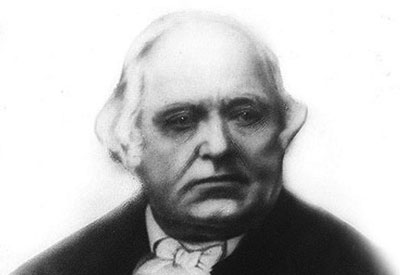
Commissioner of Agriculture
Before the Department of Agriculture became a Cabinet-level agency in 1889, the head of the USDA was called the Commissioner of Agriculture. In 1862, President Lincoln appointed Isaac Newton the first Commissioner. The act creating the USDA directed the Commissioner to:
“acquire and preserve in his Department all information concerning agriculture which he can obtain by means of books and correspondence, and by practical and scientific experiments (accurate records of which experiments shall be kept in his office), by the collection of statistics, and by any other appropriate means within his power to collect, as he may be able, new and valuable seeds and plants to test, by cultivation, the value of such of them as may require such tests to propagate such as may be worthy of propagation, and to distribute them among agriculturists.”
Questions
How is the Secretary of Agriculture selected today? To whom does he/she report?
Why is this position so important?
G. Baker, J. Porter, W. Rasmussen, and V. Wiser, eds., Century of Service: The First 100 Years of the United States Department of Agriculture (Washington, D.C.: Centennial Committee, U.S. Department of Agriculture, 1963).
The Civil War destroyed much of the South and its plantations. More dramatically, four million slaves were suddenly freed with no land, no money and little opportunity. A tenant farming system called sharecropping evolved in the South to make use of cheap labor. Sharecropping employed ex-slaves and other poor workers to farm the cotton and tobacco fields of landowners in exchange for part of the harvest. This system persisted for decades, even though sharecroppers were frequently cheated and exploited.

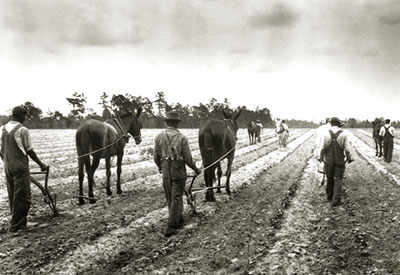
Post-war Agriculture in the South
The following account describes life in postwar Georgia.
The southern states were devastated by the Civil War. Georgia, for example, lost sixty-six percent of its developed resources during the war. Post-war farming practices in the south were in the midst of monumental changes as former slaves were emancipated. Prior to the war there were more than a thousand plantations in Georgia that were at least one thousand acres in size, but after the war farm size was based on the area a man could manage through his own labor, with the assistance of his family or contracted labor. In addition:
The plantations (farms) of the country were in a rough and dilapidated condition generally: stock, mules and horses for plow-teams were scarce, as was also grain to feed them . . . most of the seed was old and imperfect from neglect during the war . . . and the laborers generally disinclined to do full work.
Questions
How did the emancipation of slaves change farm life in the southern states?
How did it change life in the rest of the United States?
P. B. Haney, W. J. Lewis, and W.R. Lambert. Cotton Production and the Boll Weevil in Georgia: History, Cost of Control, and Benefits of Eradication, Georgia Agricultural Experiment Stations, College of Agricultural and Environmental Sciences, University o


Plowing with Mules
Until the invention of tractors, horses and mules were the primary source of power for farmers to do their work on the farm and ranch. Examine the image above of a farmer plowing his field. A team of two horses or mules pulling a walking plow could work only about two acres per day. This limited the practical size of the farm for one farmer to about one hundred acres. In contrast, when early steam tractors became available after 1868, they could plow an acre in just half an hour.
Questions
How many acres could a farmer plow in a twelve-hour day with a steam plow?
What impact do you think changing from horse to machine power had on the average size of farms in America?
What factors may have kept some farmers from modernizing to steam- and later gas-powered tractors?
What factors today keep people from adopting new technologies for work?
What factors encourage them to adopt new technologies?
Farming in the 1920s: Machines, Wessels Living History Farm, York, Nebraska [online]; and Franklin Harris and George Stewart, The Principles of Agronomy (New York: Macmillan, 1930).

Sharecropping
Sharecropping is often thought of as an activity that involved only poor African American farmers. However, many sharecroppers were poor white farmers. Below is an excerpt from “Better a Tent than a Mortgage,” the oral history of a poor white farmer named Walter Strother, collected by writer L. E. Cogburn as part of the Federal Writers’ Project (1936–1940). This government project provided work for many writers during the Great Depression.
“I was born on the Wateree River fifty years ago, and lived there until I was six years old. My father then moved to Derrick’s Pond, about seventeen miles southeast of Columbia, [South Carolina]. The next year, when I was just seven years old, my father left us. I am the oldest of his family of seven children.
“In order to help my mother support our family, I had to plow in the fields at the age of eight years. I became a regular plowhand by the time I was ten. Mr. [Kerningham?], on whose place we lived, hired me by the day, at a wage of forty cents a day. We earned so little that my mother could afford to buy only the bare necessities. There were days that we had to go hungry. I, in the meantime, had received but a few months of schooling. I didn’t have time to go to school. I had to work.
“When I was twelve years old, and my brothers were large enough to help I asked Mr. Kerningham to let us work a sharecrop. I felt that this would afford us more to eat, because of an advance on a sharecrop.
“I’ll never forget the morning I went to Mr. Kerningham and asked him for a sharecrop. He was fixing to go to Columbia. Already had his horse hitched to the buggy. He said to me, ‘Son, you can’t manage a farm.’ I looked at him square in the face and said, ‘Give me a chance.’ He told me he would think it over, and for me to come back in a few days. I didn’t wait. I went back the next day, and he said, ‘Walter, I have decided to do it. When do you want to move?’ ‘Right away,’ I told him. ‘Go and catch Kit and Beck and hitch them to the wagon and move,’ he told me.
“That year, I made seven bales of cotton and plenty of corn, peas, and potatoes. And we didn’t have to go hungry at any time.
“Mr. Kerningham used the lien system to run his farm. He traded with M. E. C. Shull, who ran a big grocery store in Columbia on Main Street, between Taylor and Blanding.
“That fall, after we started to pick cotton, I went to Mr. Kerningham and said, ‘I have a bale of cotton out.’
“’You know you haven’t a bale already,’ he replied.
“’Yes, I have, too.’
“’When do you want to gin it? It’s bringing a little more than eight cents now.’
“’I’ll do as you say. You know best.’
“’Suppose you gin it tomorrow,’ he said.
“He had a gin on the place, and the next day I had it ginned. I went to Mr. Kerningham and said, ‘I want you to sell it for me.’
“’No, you take the wagon and haul it to Columbia and sell. I’ll meet you at the store.’
“I tied my mules to the hitching post on Assembly Street. I remembered how my father did when he sold cotton. I cut the side of each bale and pulled a sample and took it to the buyer and asked him what he would bid on it. Taking the samples and examining them he said, ‘I’ll give you eight cents. Might give you more after I see the bales. Where are they?’ We went to the wagon, and he pulled a sample from each bale. After examining it, he said: ‘I’ll give you eight and a half, if you’ll sell it now and not try to get a higher bidder.’
“I sold it to him and took the check to the store and met Mr. Kerningham. He said to me, ‘Have you sold your cotton?’
“’Yes, sir,’ I replied. And at the same time I handed him the check.
“’What did you get for it?’ he asked.
“’Eight and a half cents a pound.’
“’That’s good.’
“We walked to the back end of the store. He sat down on a bag of oats, and I sat on,--I don’t remember what. I didn’t know much ‘rithmetic, but I had already counted up what was to come to me. He was dividing it up, after taking off the cost of bagging and ties and ginning. He said to me, ‘You have so-and-so for your part. How much do you want?’
“’Not a dime.’
“’You don’t want any at all?’
“’No, sir. Put it to my credit on my account,’ I told him.
“I furnished the labor and paid for half the fertilizer, and he furnished and fed the stock and paid for half the fertilizer. We divided everything that was made half-and-half, except the potatoes. I had all of these that I made.
“I worked this way two years with Mr. Kerningham. Saw that he was getting the best of it, as I thought then. But there wasn’t the slightest misunderstanding between us.
“The next year, I moved away from him and rented. I bought a plug mule and got one of those liens. Had a bad crop year, and didn’t make enough to pay the rent and lien. I took the mule back to the man I bought it from. He didn’t have to come for it. I explained to him that I had nothing to pay, and he was mighty nice about it. Took the mule back and didn’t blame me.
“I sold everything to settle up and was left flat again, like the first time I went to the old man.
“I found out that I made a mistake when I left Mr. Kerningham. I went back and asked him for a crop again, and he gave it to me. I was a pretty big boy then, whole lot of difference from the first time.
“This year I made a good crop, got a fair price for it, and cleared a little money.”
Questions
What is the farmer’s attitude about sharecropping?
What lessons, if any, can be learned from the way Walter Strother faced the challenges of his life as a sharecropper?
L. E. Cogburn, Better a Tent Than a Mortgage, American Life Histories: Manuscripts from the Federal Writers Project, 19361940, Library of Congress, American Memory [online].

Reconstruction
The period of rebuilding in the South after the Civil War was called “Reconstruction.” Here is an account of Reconstruction from a publication by the National Park Service.
“Although the exact dates demarcating Reconstruction are not universally agreed upon, Eric Foner indicates the years 1863 to 1877: the period from the Emancipation Proclamation to the year that the ideal of Reconstruction to protect the fundamental rights of all citizens gave way to southern ‘Redemption’ and ‘home rule,’ the equivalent to white rule. (Still others might point to 1883 as the end of Reconstruction, the year the Supreme Court declared the Civil Rights Act of 1875 unconstitutional.) By law, at least, African Americans made significant gains for their rights as citizens during Reconstruction. Racism prevailed however, and once ‘Southern Redemption’ took hold by the 1880s, racist policies continued and proliferated. Federal laws, Supreme Court decisions, and presidential initiatives would vacillate between furthering and hindering the civil rights of African Americans.
“Following the Civil War, Congress amended the Constitution in ways that confirmed American democracy and raised the hopes of African Americans for attaining equality. The Thirteenth and Fourteenth Amendments of 1865 and 1867 ended the institution of slavery and guaranteed equal protection under the law regardless of race, respectively. The adoption of restrictive ‘Black Codes’ by southern states however, sought to secure white supremacy and keep blacks as a laboring class. President Andrew Johnson’s moderate policy supported the concerns of the South and did little to advance blacks’ civil rights. Nonetheless, Congress passed bills to ensure civil rights and enforce Reconstruction in the South with the passage of a civil rights bill in 1866 and the Reconstruction Act of 1867 (i.e., ‘Radical Reconstruction’). Finally, the passage of the Fifteenth Amendment in 1869 allowed black men to vote.
“The federal government did much to improve and aid the newly freed slaves through the establishment of the Freedmen’s Bureau in 1865. Among the many services provided, the Bureau supplied legal aid, set up schools, and provided health care. Also during Reconstruction, African-American men gained seats in Congress: two in the Senate and twenty in the House of Representatives. Despite the accomplishments, racism operated to subvert equality and justice.
“The economic depression of the 1870s was particularly severe in the South: yeomen farmers were engulfed by poverty and planters by indebtedness. Just as African Americans were increasing their political influence, the depression limited their power to influence working conditions: independent black farming became difficult so that most owners and renters were reduced to sharecroppers and wage laborers. Resentment and resistance among white southerners would increasingly undermine the law of the land through organized acts of violence and state legislation.
“Supreme Court decisions hastened the end of Reconstruction. Under the Enforcement Act of 1870, indictments were made against several southerners who were charged with preventing blacks from voting. In 1875, the Court’s decisions favored the defendants and interpreted the Fifteenth Amendment in an ambiguous fashion. By 1877, radical Republicanism gave way to conservative policies favoring southern Democrats and ‘home rule’ was restored to southern states. Finally, the Civil Rights Act of 1875 was declared unconstitutional in 1883 and the constitutional laws that were supposed to guarantee African-American citizenship rights were successfully subverted.”
Questions
What were the goals of Reconstruction?
What obstacles did Reconstruction face?
How well were the goals of Reconstruction achieved?
Theresa Anne Murphy, Scholarship on Southern Farms and Plantations, National Park Service [online].
Farmers began to form organizations to fight for their interests, improve rural life, and increase agricultural education for their members.

The Grange Organization
Since the 1700s, American farmers have formed organizations to promote and support agricultural and farmer interests. Early farm organizations during the eighteenth century took the form of agricultural societies with the primary purpose of exchanging useful information. During periods of economic stress, farmers sometimes formed other short-lived groups whose motives were to change government policies and improve the economic conditions of farmers.
Visit the website of the National Grange of the Order of Patrons of Husbandry, and then answer the following questions.
Questions
Why was the Grange organized?
What purpose did it serve in the past and what purpose does it serve today?
What role can organizations such as this play in influencing government decisions?


In 1870 nearly half of all Americans worked as agricultural laborers and more than three-fourths of America's exports were agricultural goods. Westward expansion pushed the agricultural frontier onto the Great Plains. The Homestead Act offered 160 acres of free land to settlers who would farm it for five years, making the Great Plains a land of opportunity. Homesteaders rushed to fill the open lands. Homesteading also brought fresh waves of immigrants in pursuit of their dreams. The Great Plains soon became America's breadbasket, the rich soil yielding bountiful harvests of wheat and corn.
The United States Department of Agriculture guided and aided much of the nation's agricultural progress during the decades of expansion. It sought out the world's best scientists and engineers; men like Seaman Knapp, who researched and promoted crop rotation and Wilbur Atwater, who started the science of human nutrition. As the USDA collected, analyzed, and published vast amounts of scientific information the frontiers of science and technology were pushed along with the borders of the expanding nation.
The westward expansion of railroads to the Pacific Ocean was extremely important to the growth and development of agriculture. Railroads carried settlers and made it possible for ranchers and farmers in the west to sell whatever they could produce.

Chisholm Trail
In the 1800s, moving cattle from range to market involved cowboys driving cattle along established trails. As railroads moved westward, ranchers were able to significantly reduce the distance they had to drive their cattle. Read about cattle trailing and the railroads at the Handbook of Texas Online to answer the following questions.
Questions
Why did ranchers want to move their cattle from Texas to other states?
Why was Abilene, Kansas, selected as a major end point on the cattle trail?
What can you learn about supply and demand from Texas cattle trailing?


Railroads
The westward push of the US population created the need for a dependable transportation system. The transcontinental railroad was the answer. Markets expanded and opportunities for trade were enhanced.
Constructed between 1863 and 1869, the driving of the golden spike was celebrated in Promontory Summit, Utah, when the final section of track was laid on May 10, 1869. Beginning from Sacramento, CA, the Central Pacific Railroad built a route through the Sierra Nevada Mountains, and the Union Pacific Railroad began laying track in Omaha, Nebraska, before meeting in Utah. Due to a labor shortage in the West, Chinese workers were recruited to work for the Central Pacific, about two-thirds of the entire work force, while the Union Pacific took on Irish immigrants and US Army veterans. Finally, the US began to think continentally, rather than locally.
For more information, see the link below:
Questions
Do you think all farmers and ranchers were glad to see the railroad come through their land?
Do you think that some of them were angry about the railroads? Why or why not?
What were the over-arching, long-lasting effects of the transcontinental railroad?

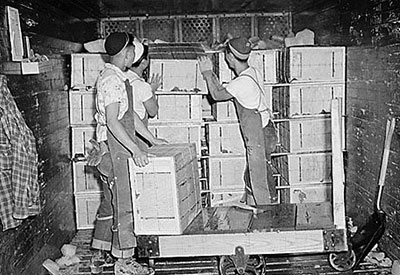
Refrigerated Box Car
Refrigerated boxcars created a national market for fresh produce for the first time. Before refrigerated transport, farmers who wanted to sell their produce across the country were left with few options. Those who chose to transport their produce by railroad risked having it rot in the extreme heat or freeze in the bitter cold.
The invention of the refrigerated railroad car in 1867 allowed farmers to deliver their products to cities across the country and gave consumers access to better and more nutritious foods.
Questions
New inventions can often solve old problems, but may present new problems as well. While the railroads solved many transportation problems, they also presented the risk of produce damage until refrigerator cars were invented. What other inventions have both solved and created problems?
Barbara Krasner-Khait, The Impact of Refrigeration, History Magazine [online].

Panama Canal
While the transcontinental railroad connected America by land, the Panama Canal helped connect it by sea. Before the canal, goods and people traveling by boat had to go all the way around the tip of South America to get from one coast to the other—a trip of eight thousand miles. Beginning in 1914, the Panama Canal shortened this trip considerably by allowing boats to travel across Panama through a series of locks. The canal, which took ten years to complete, was an amazing engineering feat for its time. Watch this black and white film (silent movie) to see how the locks working in 1914. Then view "How Does the Canal Work" for a modern explanation.
Questions
- Why was the Panama Canal important to America?
- How would this canal help agriculture?
- What other transportation advances have helped commerce in America?
Text adapted from Library of Congress, Americas Story from Americas Library, Jump Back in Time: The Modern Era (online); stock newsreel excerpts obtained from CBS, c. 1913-1914, courtesy of U.S. National Archives and Records Administration.
The United States Department of Agriculture guided and aided much of the nation’s agricultural progress during the decades of expansion. It sought out the world’s best scientists and engineers; men like Seaman Knapp, who researched and promoted crop rotation and Wilbur Atwater, who started the science of human nutrition. As the USDA collected, analyzed, and published vast amounts of scientific information the frontiers of science and technology were pushed along with the borders of the expanding nation.


Grasshopper Commission - Charles Riley
From 1873 to 1877, grasshoppers from the Northwest invaded many Western States and territories. In some states the destruction of crops was so serious that it caused starvation among pioneer families. USDA entomologist, Charles Valentine Riley, studied the plague and worked to bring it to the attention of Congress. In March of 1877, he succeeded in securing passage of a bill that created the United States Entomological Commission (sometimes called the Grasshopper Commission).
Questions
What does an entomologist do?
Why was it important for the USDA to have a group of entomologists?
Entomologists are agricultural scientists who do not work on farms; what other agricultural careers are not located on farms?
The National Agricultural Library [online].
Increases in farm production throughout most of the nation’s history had come mainly from the development of new land, but by the late 1800s poor farming practices had depleted nutrients in the soil – and agricultural production and quality began to decline. Previously, farmers had just plowed up new land when this happened, but now they began to push for scientific knowledge to improve agriculture. While most farmers had little understanding of the proper treatment of soil or plants, scientists were making new discoveries that would revolutionize agriculture. The 1887 Hatch Act established agricultural experiment stations in connection with the Land Grant Universities in each state. The State Agricultural Experiment Stations worked to help farmers find practical solutions to agricultural problems.

Experiment Stations
By the 1800s, scientists were beginning to realize the potential benefits science could bring to agriculture; however, scientific information did not always reach the farmers who needed it. During the mid-1870s, two men, Samuel W. Johnson of Connecticut and Eugene W. Hilgard of California, worked to solve this problem by establishing agricultural experiment stations in their states. In 1875, Johnson, an agricultural chemist, helped found the first State Agricultural Experiment Station in Connecticut, modeled after those he had seen in Germany. Hilgard, also a chemist, founded an experiment station at the University of California a few months after the Connecticut station began operations.
In 1887, the Hatch Act authorized grants to fund agricultural experiment stations at each of the land-grant universities established by the Morrill Act of 1862. Congress established these stations to conduct agricultural research and to distribute the information and knowledge created through scientific discovery to farmers. The federal governments support of agricultural research continues today at land-grant and other colleges and universities, as well as at experiment stations.
Questions
Why would the federal government promote agricultural research?
What role does research serve in the advancement of a nation?
What is the purpose of disseminating information and research results to the community?
What role does research play in improving the community?
G. Baker, J. Porter, W. Rasmussen, and V. Wiser, eds., Century of Service: The First 100 Years of the United States Department of Agriculture (Washington, D.C.: Centennial Committee, U.S. Department of Agriculture, 1963).
As the USDA shared its discoveries with the American public the landscape began to change. Farmers returning to their crops and livestock from agricultural science schools and agricultural demonstration and extension programs began experimenting with new techniques to improve production.

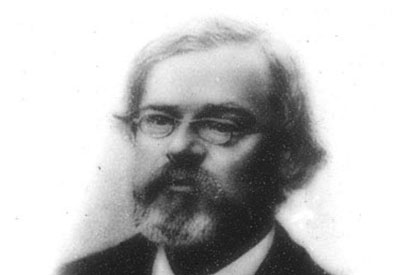
Entomology at the USDA
One of the first entomologists (insect scientists) employed by the USDA was Townend Glover. USDA Commissioner Newton encouraged Glover to start a museum containing Glover’s extensive collection of insects, as well as models of fruits. Commissioner Newton established an agricultural museum on August 1, 1864, with Glover as curator.
Today, Glover’s insect collection is part of the National Entomological Collection jointly managed by the USDA and the Smithsonian’s National Museum of Natural History. The collection, which is one of the largest in the world, contains thousands of specimens from the United States and all parts of the world. The large holdings of agriculturally important species make this collection an important source for research and for identification of insect pest groups.
Questions
How can the study of insects advance our knowledge about agriculture?
Why is agriculture influenced so strongly by insects?
What insects would you study if you were an entomologist?
G. Baker, J. Porter, W. Rasmussen, and V. Wiser, eds., Century of Service: The First 100 Years of the United States Department of Agriculture (Washington, D.C.: Centennial Committee, U.S. Department of Agriculture, 1963).


Insects and Agriculture
Organic insecticides have been researched and used for many years in America. Read this brief history of insecticides from The Yearbook of Agriculture, 1962.
Potato growers in the Eastern States were alarmed in the 1860s by the advances of the Colorado potato beetle. Nothing was effective against it until someone began to use paris green, an arsenic compound, that had been used for many years to color paints, wallpaper, and fabrics. Later it was fond to be effective against cankerworm on fruit trees, the codling moth, and the cotton caterpillar. For many years the standard agricultural insecticides were paris green or London purple (another arsenical) for chewing insects and kerosene-soap emulsion for sucking insects. Pyrethrum [a substance extracted from chrysanthemums, a variety of soaps, and oil from the Neem tree] was used for household insects. Efforts to combat the attacks of the gypsy moth in New England forests led in 1892 to the use of lead arsenate, which was more effective than paris green and less injurious to foliage. Great amounts of lead arsenate were used later in orchards against the codling moth and many other insects. Powdered lead arsenate was tried against the boll weevil on cotton. It gave some control and led to the development [in] about 1916 of calcium arsenate, which came into use throughout the Cotton Belt. Lime-sulfate was used against San Jose scale beginning in 1880. The fumigation of citrus trees in California with hydrocyanic acid gas was started in 1886.
Questions
Why was it important to research and develop effective insecticides?
Is it as important today?
The Yearbook of Agriculture, 1962 (Washington, D.C.: U.S. Department of Agriculture, 1962).


The Civil War destroyed much of the South and its plantations. More dramatically, four million slaves were suddenly freed with no land, no money and little opportunity. A tenant farming system called 'sharecropping' evolved in the South to make use of cheap labor. Sharecropping employed ex-slaves and other poor workers to farm the cotton and tobacco fields of landowners in exchange for part of the harvest. This system persisted for decades, even though sharecroppers were frequently cheated and exploited.
Men like Booker T. Washington and George Washington Carver worked to improve the lives of former slaves as well as all Southern farmers. Booker T. Washington believed that education was the way to true emancipation. He became the first head of the Tuskegee Institute in Alabama, which emphasized agricultural and industrial training for African Americans.
George Washington Carver was an agricultural scientist who headed the agricultural department at Tuskegee. Carver taught his students how to conserve the soil by diversifying and rotating crops. Carver traveled by wagon demonstrating better farming methods to black farmers. He introduced profitable new crops for Southern farmers to grow in place of cotton. He also developed new varieties of peanuts and discovered new uses for peanuts, giving the South a whole new industry. The United States Department of Agriculture later adopted Carver's demonstration methods, bringing research directly to farmers when it created the Extension Service.
Booker T. Washington and George Washington Carver worked to improve the lives of former slaves as well as all Southern farmers. Booker T. Washington believed that education was the way to true emancipation. He became the first head of the Tuskegee Institute in Alabama, which emphasized agricultural and industrial training for African Americans.

Booker T. Washington
Explore the overview of the life of Booker T. Washington at the National Park Services website: Legends of Tuskegee.
Questions
Why did Booker T. Washington believe so strongly that education was the way for African Americans to achieve true freedom?
Why were agricultural studies such an important part of the Tuskegee Institute?
What personal qualities made Booker T. Washington such a great educator and leader?


Thomas Monroe Cambell and the Tuskegee Movable School
Booker T. Washington was the principal of what would become Tuskegee University. This first all black college was founded on July 4, 1881. George Washington Carver became an educator and was engaged in science that would aid southern farmers. While the accomplishments of these two men are well documented, there is another name that belongs with these two and that is Thomas Monroe Campbell. He was the first African-American extension agent in the United States and was responsible for implementing the Tuskegee Movable School.
"On the first day at Tuskegee Thomas was asked what trade he wanted to learn. It was suggested he study agriculture and he said OK (not realizing that really meant farming). He was assigned to work with the livestock division; specifically, at the horse barn working with the horses.
He then went to the Academic Department to take his entrance exams. The results were not good. He was admitted as an “unclassified” student which meant he would have to take remedial night classes before he could take even the lowest level courses.
It took Thomas seven years to complete his education at Tuskegee. He considered George Washington Carver to be a mentor. During the summers he worked at a variety of challenging jobs in order to pay for his schooling.
Because of his work in the horse barn, Thomas got to know Booker T. Washington on a personal basis. Thomas cared for the horses that pulled Washington’s buggy and became his personal driver. He would drive Washington to the train station and pick him up when he returned from trips. Thomas also drove Washington and his many prominent guests around Tuskegee when they came to visit. As he escorted the guests around, he heard Washington discussing the problems facing the rural south.
After graduating from Tuskegee in the spring of 1906, Campbell decided to pursue graduate study and had just started his advanced studies at Tuskegee when he was appointed by the federal government to the position of “Negro Extension Agent.” Both Carver and Washington supported this appointment. The appointment was effective November 10, 1906 (eight years before the Smith-Lever Act was passed). He was stationed at Tuskegee and given the responsibility of working with the Negro farmers in the area surrounding Tuskegee. Harper and Walcott (2019) state that Thomas Monroe Campbell was the first extension agent in America."
Visit this webpage to learn more about Campbell's work with the Jesup Wagon and his impacts working rural African American farmers.
Questions
What were the hoped for outcomes of the movable school?
Why was Thomas Monroe Campbell considered the first "extension agent."?
Why was is the word "extension" used?
Gary Moore, Professor Emeritus, Agricultural and Extension Education, North Carolina State University
George Washington Carver was an agricultural scientist who headed the agricultural department at Tuskegee. Carver taught his students how to conserve the soil by diversifying and rotating crops.

George Washington Carver - A Tuskegee Legend
Explore the overview of the life of George Washington Carver at the National Park Services website: Legends of Tuskegee.
See the National Park Service website
Questions
What sacrifices did George Washington Carver have to make to get an education?
What sacrifices do people in our time have to make to get an education?
Contrast and compare these differences. Why should a person make these sacrifices?
What was the purpose behind all of George Washington Carver's many scientific research efforts? Who benefited from his research?
Why did he create a moveable school?
Why would colleges and universities want or need to extend themselves to reach out to students outside of traditional classrooms?


George Washington Carver: Teacher and Innovator
George Washington Carver traveled by wagon demonstrating better farming methods to black farmers. He introduced profitable new crops for Southern farmers to grow in place of cotton. He also developed new varieties of peanuts and discovered new uses for peanuts, giving the South a whole new industry. The United States Department of Agriculture later adopted Carver's demonstration methods, bringing research directly to farmers when it created the Extension Service.
Questions
How did George Washington Carver's teaching and innovations impact the Southern economy?


The westward expansion of railroads to the Pacific Ocean was extremely important to the growth and development of agriculture. Railroads carried settlers and made it possible for ranchers and farmers in the west to sell whatever they could produce.
Increases in farm production throughout most of the nation's history had come mainly from the development of new land, but by the late 1800s poor farming practices had depleted nutrients in the soil - and agricultural production and quality began to decline. Previously, farmers had just plowed up new land when this happened, but now they began to push for scientific knowledge to improve agriculture. While most farmers had little understanding of the proper treatment of soil or plants, scientists were making new discoveries that would revolutionize agriculture.
Farmers began to form organizations to fight for their interests, improve rural life, and increase agricultural education for their members.
The 1887 Hatch Act established agricultural experiment stations in connection with the Land Grant Universities in each state. The State Agricultural Experiment Stations worked to help farmers find practical solutions to agricultural problems.
Increasing mechanization continued to improve the productivity of American farmers. Scientists also discovered new crops for American farmers to grow and develop new breeds of livestock to provide more meat, milk, eggs and wool. Consumers became aware of food safety and quality and demanded that the government take action to regulate food.

New Wheat Varieties
Throughout its history, one of the tasks of the Department of Agriculture has been to search the world for new plant and animal types in order to increase the variety of our nations food supply and to ensure the productivity of American agriculture. The following account is a description of how one American scientist vastly improved our countrys wheat, and possibly saved the nation from famine.
In 1898, experts were predicting food shortages and famine because the increasing population would overtake our ability to grow sufficient wheat by 1931. They may have been right--except 1898 was also the year U.S. Department of Agriculture special agent Mark A. Carleton was sent on his first plant exploration trip to Russia. He brought back new durum and hard red wheat varieties to grow in the United States.
Five years after the introduction of that wheat from Russia, wheat production in the United States exploded from sixty thousand to twenty million bushels a year. The drought tolerance of these new varieties opened up the Great Plains and the Northwest for wheat growing, the durum wheat tasted better in pasta, and the hard red wheat made better bread.
The USDA official who sent Carleton on his 1898 collecting trip later wrote, We have forgotten how poor our bread was at the time of Carletons trip to Russia. In truth, we were eating an almost tasteless product, ignorant of the fact that most of Europe had a better flavored bread with far higher nutritive qualities than ours.
More than one hundred years later, USDA plant exploring and collecting, now under the direction of the Agricultural Research Services National Germplasm Resources Laboratory, is still a critical ingredient in maintaining and expanding agricultures ability to feed an ever-growing population.
Questions
How does the collecting and stockpiling of plants at the USDAs National Germplasm Resources Laboratory increase productivity and ensure the safety and security of our nations food supply?
In what other ways is agriculture critical to the safety and security of our nation?

Carver Discoveries
One of the most significant early agricultural researchers was George Washington Carver of the Tuskegee Institute in Alabama. During his first twenty years at Tuskegee, Dr. Carver scoured his imagination to produce as many products as possible to help create a demand for crops other than cotton in the south. He is most famous for his products made from peanuts, but he also studied many other crops.
Examine some of the research discoveries of George Washington Carver.
From peanuts: over three hundred products including: milk, cheese, cream, coffee, plastics, paper, wood stains, flour, soap, linoleum, cooking oils, cosmetics, and medicinal massaging oils.
From sweet potatoes: over one hundred-eighteen products including: starch, tapioca, mock coconut, molasses, breakfast foods, feed for livestock, dyes, flour, vinegar, ink, and synthetic rubber.
From soybeans: flours, coffee, cheese, sauce, bisque for ice cream, oil, chick food, soup mixtures, bran, and stock food.
From waste and native materials: rugs, table runners, table mats, scarves, fuel briquettes, floor mats, synthetic marble, wallboard, wood veneers from yucca and Florida palm, vegetable dyes, etc.
From cotton: paving blocks, cordage, paper, fiber for rope, and many other products.
From the clays of Alabama: face powder, pigments for paints, wood stains, wallpapers, and calcimines.
Questions
Which of Carvers discoveries surprise you, and why?
Although these discoveries all come from agricultural products, many of them are for purposes other than agriculture. Which of the products he discovered are used for manufacturing rather than for agricultural purposes?
If you were an agricultural scientist like George Washington Carver, what could you invent from the apple or some other agricultural product?
National Agricultural Library [online].

Guano Islands Act
The Guano Islands Act (enacted August 18, 1856) is a United States federal law passed by the U.S. Congress that enables citizens of the United States to take possession of unclaimed islands containing guano deposits. Watch this Youtube video segment to answer the questions.
Questions
Why was the U.S. be intersted in obtaining guano (bird droppings)?
Why did the U.S. stop using guano?
Scientists also found new ways to fight animal and plant diseases. In 1890, USDA scientists proved for the first time that a disease-producing organism could be spread between animals by a carrier. This groundbreaking discovery led to the development of control measures to combat many other diseases carried by insects that affected animals as well as people, including malaria, typhus, yellow fever and bubonic plague.

Cattle Fever
In 1890, a disease among cattle caused widespread losses for ranchers, especially in the South. Southern cattle were often driven to northern markets, spreading a trail of disease along the way. Northern cattle, taken to the South for breeding, often contracted the disease and died. Go to the Agricultural Research Service website to learn how early scientists at the U.S. Department of Agriculture solved the mystery of this previously unknown fever and ended a significant agricultural problem.
See the Agricultural Research Service website
Questions
What was the cause of this fever in cattle?
How did the USDA researchers determine the cause?
What scientific breakthrough did this research lead to, and how did it help solve other major illnesses?


Microscopes
Although Hans and Zacharias Janssen of Holland built the first compound microscope around 1595, it took several centuries for the microscope to become a common scientific instrument. Many inventors made improvements over time, so that by the 1800s the basic design of the microscope was firmly in place.
Widespread use of the microscope during the late nineteenth century revolutionized science, including the study of agricultural science at the Department of Agriculture, where a special Division of Microscopy was established in 1871. USDA scientists soon began studying plant diseases using the latest microscope technology, as described in the following excerpt.
"Systematic study of diseases of plants began in 1871, when Thomas Taylor was appointed to head the newly created Division of Microscopy. Taylor had been trained in science in his native Scotland and in medicine at Georgetown University. He was enthusiastic about the potential value of the microscope in agricultural research, and his division was given the responsibility for all work with microscopes in the Department. Taylor made some outstanding contributions on plant disease. The Division of Microscopy was abolished July 1, 1895, after which other divisions were permitted to use microscopes."
Questions
How did the use of microscopes improve agricultural research?
How has this tool benefited other fields?
What other inventions have influenced the advancement of scientific research?
G. Baker, J. Porter, W. Rasmussen, and V. Wiser, eds., Century of Service: The First 100 Years of the United States Department of Agriculture (Washington, D.C.: Centennial Committee, U.S. Department of Agriculture, 1963); and Helen R. Purtle, History of t
USDA scientists also had major success using a predatory insect to control an agricultural pest that was ruining Californias citrus industry. The Vedalia Beetle was brought into California to control the Cottony-cushion scale insect. The outstanding success of this project led to more research and efforts using predator insects.

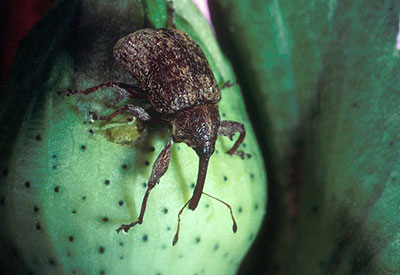
Boll Weevil
One pest that farmers and scientists have had to fight is the boll weevil. Boll weevils, which entered the United States from Latin America in the 1890s, destroyed cotton crops. They were especially devastating in the South in the 1910s and ’20s. Some farmers survived by planting different crops, but many lost their farms when their cotton crops were ruined.
Questions
Historically, what other insects or diseases have destroyed farmer livelihoods, communities, or even countries?
Was it important for farmers to kill the boll weevils?
What weapons did farmers have to use against boll weevils?
Text adapted from Library of Congress, Today in History: December 11th (online); film Goodbye, Boll Weevil, 1921, courtesy of U.S. National Archives and Records Administration.
By the end of the 1800s, many new discoveries were changing the way Americans farmed. One of the most important scientific advances of this period was the discovery that plants could be selectively bred for disease resistance. The principle of selective breeding expanded to encompass other desirable traits such as drought resistance, plant quality and nutrition.

Food and Nutrition
The nineteenth century saw many changes as scientists discovered new knowledge that would impact the daily lives of all Americans. Wilbur O. Atwater was one of those scientists. In 1869, he published tables showing the chemical composition of foods. For his groundbreaking work, Atwater is known as the Father of Human Nutrition. Read the following excerpt about Atwaters efforts.
In early 1893, the odds that Wilbur Olin Atwater would get public support for his grand plan for food investigations were slim to none. In fact, the future of the Office of Experiment Stations, which he had worked hard to establish, was in doubt. But as often happens to people of vision, an angel interceded in the form of a close personal friend of the Secretary of Agriculture who knew and admired Atwater.
On May 23, the Secretary wrote: "Mr. Edward Atkinson of Boston suggests the expediency of establishing food laboratories . . ."
With those simple words, the door was pried open for the first federal funding of human nutrition research in the United States. Although it took another year of intensive skirmishing and skillful diplomacy, Atwater's efforts paid off. In May 1894, the agricultural appropriations bill included ten thousand dollars for food investigations.
At that time, knowledge of nutrients and their functions was very limited. It was known that carbohydrates and fat provided energy to maintain body temperature and do muscular work, and protein had the added duty of building and repairing tissues, but vitamins were unknown. Only a few major minerals, such as calcium and phosphorus, were recognized as somehow essential but their role in the body was unclear.
Atwater's quest for scientific understanding of nutrition was coupled with the social consciousness of the day. In an 1894 letter, he wrote: "The individual man is coming to realize that he is his brothers keeper, and that his brother is not only of his household but may live on the other side of the world. With all these thoughtful people the conviction is growing that there is one fundamental condition of the intellectual and moral elevation of the poor, the ignorant, the weak, the destitute, namely the improvement of their physical condition."
As a special agent for USDA, Atwater scouted top European laboratories and solicited articles and abstracts from the foremost researchers in agricultural and human nutrition studies. These were translated and printed in the Experiment Station Record, one of three periodicals Atwater began as director of USDA's Office of Experiment Stations.
In the ten years that Atwater headed the federal nutrition program, he conducted or coordinated research in four areas:
--Types and amounts of foods consumed by different groups.
--Chemical composition of foods.
--Effects of cooking and food processing on nutritional quality.
--Learning about the amounts and types of nutrients people need to function at their best entailed studies of human metabolism and respiration.
Atwater oversaw more than three hundred food consumption studies of families and institutions in seventeen states, which involved more than ten thousand men, women, and children. These included students, college athletes, the families of professional men, mechanics, farmers and laborers, in widely separated states and of diverse ethnic groups.
Concerned about the nutrition of the poor and disadvantaged, Atwater supervised intake studies of black sharecroppers, Mexican families, poor whites, and inmates in state mental institutions. His observations ring true even today: "The differences in diet . . . are influenced, to some extent, by race habits, and to a still larger extent, by the material conditions of the consumer . . . especially the income."
Atwater left no stone unturned in gathering data on the eating habits of people worldwide. He scoured European literature, wrote to missionaries in India, and cited studies of Chinese people living on the U.S. Pacific coast, among others.
In 1896, Atwater and Wesleyan graduate student A. P. Bryant published The Chemical Composition of American Food Materials, or simply, Bulletin No. 28. This bulletin became the forerunner of USDAs Agriculture Handbook, which is the dietitian's bible. [The Agriculture Handbook is no longer published. The current USDA product is the National Nutrient Database for Standard Reference.] It listed the minimum, maximum, and average values of the known nutrients in all American foods analyzed by July 1895.
A 1906 reprinting of the bulletin, with only minor changes, stood until June of 1940--when USDA Circular No. 549 was published. Gortner noted," I'm sure that [Atwater] could not have anticipated that it would not be superseded until some 40 years later."
Questions
What were Wilbur Atwater's motivations as a researcher?
What were some of his approaches to conducting research?
What did he do with his research findings?
How might you be benefiting today from the nutritional research of Wilbur Atwater and those who have followed him into the field of nutritional science?
ARS Timeline: 138 Years of Ag Research, U.S. Department of Agriculture [online].


By 1900 industrial technology had brought widespread improvements to farmers. Dams supplied irrigation water to dry land and USDA scientists introduced American farmers to new plants, including nectarines from Afghanistan, broccoli and seedless raisin grapes from Italy and a new avacado from Chile - greatly expanding what American farmers could grow and what ordinary Americans could enjoy at the table.
Foreign demand for America's food surplus increased and Europe became America's largest customer. In 1906 Congress passed the Pure Food and Drug Act. This legislation required the USDA to inspect the cleanliness of agricultural goods. Higher standards for production improved foreign trade and benefited ordinary Americans by improving food quality.
As the new century dawned, machines had drastically reduced the amount of manpower required on farms. This increased productivity freed more Americans to pursue new endeavors in industry and in the arts and sciences. Fewer people and less land could produce the same amount of food.
By 1900 industrial technology had brought widespread improvements to farmers. Dams supplied irrigation water to dry land and USDA scientists introduced American farmers to new plants, including nectarines from Afghanistan, broccoli and seedless raisin grapes from Italy and a new avocado from Chile - greatly expanding what American farmers could grow and what ordinary Americans could enjoy at the table.

Bureau of Reclamation
"Established in 1902, the Bureau of Reclamation is best known for the dams, power plants, and canals it constructed in the 17 western states. These water projects led to homesteading and promoted the economic development of the West. Reclamation has constructed more than 600 dams and reservoirs including Hoover Dam on the Colorado River and Grand Coulee on the Columbia River." Visit the website Reclamation: Managing Water in the West to answer the following questions.
Questions
Why has the government spent millions of dollars to move water to the arid western states?
Which reclamation projects are you familiar with, and what are their purposes?

Exploring and Collecting Plant Life
In 1927, Congress established the National Arboretum as a part of the Department of Agriculture to develop, cultivate, and preserve fast-growing pest- and disease-resistant strains of pulp trees, shrubs, and woody plants. Since its inception, the USDA and other government agency scientists have been exploring and collecting plants from across the country and around the world. Visit the U.S. National Arboretum website to read about five plant scientists and their contributions.Today the arboretum, located in Washington, D.C., conducts research and educational programs and manages 446 acres of gardens that conserve and showcase plants that enhance the environment. The arboretum researchers also produce the USDA’s Plant Hardiness Zone Map to help farmers and gardeners learn which crops and plants will do best in their region of the country.
Interactive USDA Plant Hardiness Zone Map
Questions
Why have these and other scientists spent their careers exploring and collecting plants?
What plants once considered exotic are now commonplace?
Look at the Plant Hardiness Zone Map to find which zone you live in. Why is it important for gardeners and farmers to know this

Hog Cholera
Animal diseases can have a devastating impact on a nation's agriculture. During the early 1900s, one disease that many USDA scientists worked to eradicate was hog cholera. In 1903, Marion Dorset of the USDA's Bureau of Animal Industry discovered that hog cholera is an ultramicroscopic virus. Learn how this discovery eventually resulted in the eradication of this ruinous animal disease.
Questions
Why does the USDA research animal diseases such as hog cholera?
How many years did it take to eradicate this disease?
What are some of the steps scientists took to do so?
What diseases are scientists working to eliminate today?

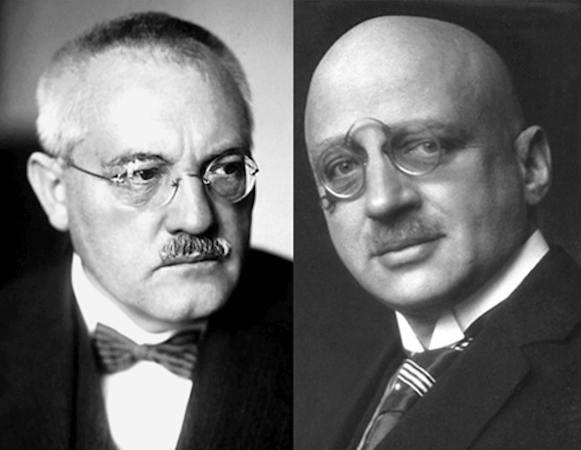
Modern Fertilizer Production
Throughout the 19th century, farmers used guano (i.e., the accumulated excrement of seabirds and bats) as highly effective fertilizer due to its exceptionally high content of nitrogen, phosphate and potassium—nutrients that are essential for plant growth. But by the beginning of the 20th century, guano deposits started to run out, and the price of the fertilizer began to increase. If a solution to the depletion of guano hadn’t come soon, famine would have followed.
Nitrogen is very common in the atmosphere, but the chemical element is difficult to extract from the air and turn into a liquid or solid form (a process known as “fixing” nitrogen) to apply to crops. Enter, Fritz Haber. Haber began studying chemistry at the age of 18 at the University of Heidelberg, Germany. Haber worked researching methods to synthesize nitrogen.
After thousands of experiments over almost 15 years, Haber succeeded in producing ammonia on July 3rd, 1909. That proved that commercial production was possible. However, Haber’s breakthrough occurred in a small tube, 75 centimeters tall and 13 centimeters in diameter. At the start of the 20th century, large containers that could handle the pressures and temperatures required for industrial scale production of ammonia did not yet exist.
That is where Carl Bosch enters the story. Born in Cologne in 1874, Bosch studied metallurgy at the University of Charlottenburg in 1894, before transferring to the University of Leipzig to receive his doctorate in chemistry in 1898. Bosch met Haber in 1908 and after finding out about the latter’s breakthrough the following year, Bosch took on the challenge of developing suitable containers that could manage Haber’s process on the industrial level.
Within four years Bosch was producing ammonia in 8-meter-tall containers. The Haber-Bosch process was born. By 1913, Bosch had opened a factory that kick-started the fertilizer industry that we know today.
Today, more than 159 million tonnes of ammonia are produced annually, and while ammonia is also used for cleaning and as a refrigerant, 88 percent of ammonia is used for fertilizer. It is estimated that if average crop yields remained at their 1900 level, the crop harvest in the year 2000 would have required nearly four times more cultivated land than was actually cultivated. That equates to an area equal to almost half of all land on ice-free continents – rather than just the 15 percent that is needed today.
Questions
While seen as a positive to produce more food with less land what negative impacts have been realized? Are there ways to mitigate and minimize these impacts?
How does the "Haber-Bosch Process" continue to impact how we live today?
https://geneticliteracyproject.org/2019/12/06/fritz-haber-and-carl-bosch-the-chemists-who-revolutionized-fertilizer-production-changing-agriculture-forever/?mc_cid=165b90e594&mc_eid=781e213462
Foreign demand for America’s food surplus increased and Europe became America’s largest customer. In 1906 Congress passed the Pure Food & Drug Act. This legislation required the USDA to inspect the cleanliness of agricultural goods. Higher standards for production improved foreign trade and benefited ordinary Americans by providing improved food quality.


Inspecting Meat Packing Plants
This is a page from a letter Upton Sinclair sent to President Roosevelt on March 10, 1906. In it, Sinclair suggested the placement of federal inspectors in meatpacking houses, and advised that these inspectors should be disguised as workers in order to discover the true conditions at the plants, as Sinclair did when he researched his book. Read this explanation of Sinclair's landmark book and answer the questions below.
"In 1905, author Upton Sinclair published the novel titled The Jungle, which took aim at the brutalization and exploitation of workers in a Chicago meatpacking house. It was the filthy conditions, described in nauseating detail--and the threat they posed to meat consumers--that caused a public furor. Sinclair urged President Theodore Roosevelt to support the presence of federal inspectors in the meat-packing houses. Both the Food and Drug Act and the Meat Inspection Act were passed in 1906."
Questions
Why did the U.S. government take responsibility for inspecting meat products for export as well as for domestic consumption?
In what other areas does the government have systems for protecting the public?
"Agency History," U.S. Department of Agriculture, Food Safety and Inspection Service [online].

FDA - USDA Origins
The origins of the U.S. Food and Drug Administration (FDA) can be traced to the assignment of a lone chemist to the U.S. Department of Agriculture in 1862. Thanks to outspoken advocates like Harvey Wiley, USDA's chief chemist, Congress passed the first federal Food and Drugs Act in 1906, giving the agency regulatory powers to protect Americans from unsafe food and drugs. The FDA remained part of the Department of Agriculture until 1940. Read this history of the FDA and answer the following questions.
Questions
Why has the FDA grown from an agency of one to an agency of over nine thousand employees?
How is your daily life impacted by the actions of the FDA? How might your life be different without the FDA?

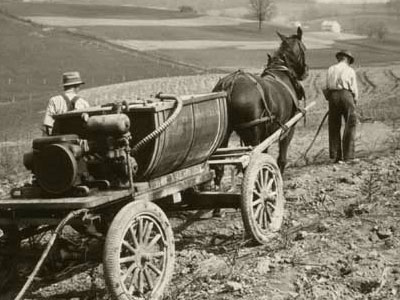
Sprayers
Questions
How might technology, such as this early sprayer being used to spray raspberries, have improved the effectiveness and efficiency of farmers in the 1930s and 1940s?
What parts of the technology appear modern and which parts are older and more traditional?
As the new century dawned, machines had drastically reduced the amount of manpower required on farms. This increased productivity freed more Americans to pursue new endeavors in industry and in the arts and sciences. Fewer people and less land could now produce the same amount of food.

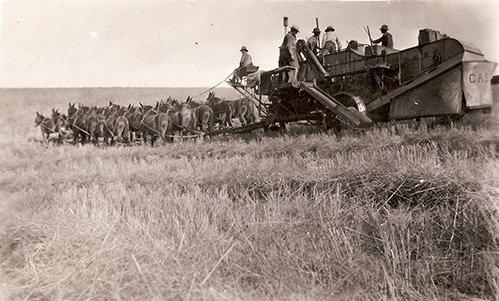
Horse and Mule Power
At the dawn of the 20th Century "horse and mule power" was being used extensively to pull farm implements for planting, cultivating, and harvesting. Some implements required more than a dozen animals to get the work done! View this video of a horse drawn harvester and consider the following questions.
Questions
What advantages and disadvantages can you think of for using horses to do farm work versus combustion engines (tractors) that would come later. Consider housing, energy, fuel, and feed consumption.

The Lowell System - Maufacturing Under One Roof
The Lowell System was a labor production model invented by Francis Cabot Lowell to move every step of the manufacturing process under one roof. Lowell's model included the use of young adult women instead of children or young men in a production line. The Lowell System, which is also sometimes referred to as the Waltham-Lowell System, was first used in the Waltham and Lowell textile mills during the industrial revolution.This system was one of the production models developed during the Industrial Revolution.
The Lowell Textile Mill is featured in this 1916 silent film which depicts the processing of wool after sheep are shorn. In Part 1, the sacks of wool arrive at a warehouse and the wool is graded and sold. At the Lowell Textile School, Massachusetts, the fleece is separated by hand, washed, dried, carded, and wound. In Part 2, wool is spun into yarn and worsted cloth is woven and then dyed. The machines and processes are nearly the same as the ones used earlier at the beginning of the Industrial Revolution. (The process is the same today but the machines are electronic, not mechanical, and they are computer-operated.)
Questions
How did Lowell's System change the textile industry?
How does this model compare with Henry Ford's assembly line?
How has automation changed the American economy?
https://historyofmassachusetts.org/lowell-mills-factory-system/


Europe became engaged in World War I in 1914. Busy fighting, these nations struggled to feed their citizens and soldiers. The U.S. Food Administration and the United States Department of Agriculture urged American farmers and ranchers to step up production to meet increased demand at home and abroad. Agricultural exports soared and farm prices more than doubled. This boom renewed business interest in farming, and in 1916 President Woodrow Wilson signed the Farm Credit Loan Act to provide long-term loans to farmers.
With money for expansion, farmers purchased nearly fifty thousand tractors and put forty million acres of new land into production in 1917. The war effort also saw meat production swell by more than 20 percent.
The explosion of agriculture fueled a search for methods to bring more land into production. Agricultural scientists like John Widtsoe developed methods for dry farming that made it possible to grow wheat and hay in arid areas of the United States without irrigation.
With war looming on the horizon and an industrial revolution that moved people from rural areas to cities, it became apparent that more people were needed to continue in the production of food and fiber (fabric). The Federal government (USDA) supported college programs for soldiers and land grant colleges with programs to educate farmers and future farmers.
National Archives

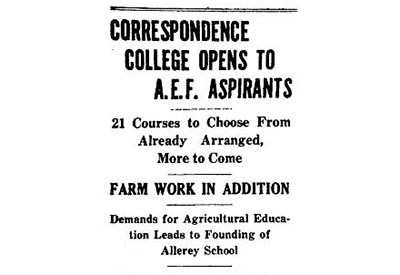
Army Correspondence College
After World War I, while the American Expeditionary Force (AEF) was on occupation duty in Europe, this headline appeared in the military newspaper The Stars and Stripes (Paris, France) on March 21, 1919, announcing the creation of an army correspondence college with agricultural courses.
Questions
Why would the army provide educational opportunities like these for American soldiers overseas?
How would such opportunities benefit agriculture in the United States?
What types of educational programs does the U.S. government provide today? Who could benefit from these programs?


County Extension Agents
This chart shows the number of counties with county extension agents from 1904 to 1924.
"Extension was formalized in 1914, with the Smith-Lever Act. It established the partnership between the agricultural colleges and the U.S. Department of Agriculture to provide for cooperative agricultural extension work. At the heart of agricultural extension work, according to the Act, was:
--Developing practical applications of research knowledge.
--Giving instruction and practical demonstrations of existing or improved practices or technologies in agriculture."
Questions
Why did the number of counties with extension agents increase so dramatically during these twenty years?
What is the value of education to someone trying to support a family?
William A. Loyd, County Agricultural Agent Work under the Smith-Lever Act, 1914-1924 (Washington, D.C.: U.S. Department of Agriculture, 1926).

4-H
When the U.S. Congress created the Cooperative Extension Service at the USDA in 1914, it included boys' and girls' clubs' work. The organization became known as 4-H--which stands for "Head, Heart, Hands, and Health." Visit the 4-H website and explore the history of the 4-H program.
Questions
Why did the U.S. Congress include boys' and girls' clubs when it created the Cooperative Extension Service at the USDA?
What was the purpose of 4-H?
What impact might a youth program such as 4-H have had on the future of American agriculture?
What does 4-H do today?
What federal, state, and local youth programs does government support today? Who are they designed to serve?
Why do various government agencies support these programs?


Cooperative Extension Services
The Smith Lever Act formalized extension in 1914, establishing USDA's partnership with land-grant universities to apply research and provide education in agriculture. Congress created the extension system to address exclusively rural, agricultural issues. At that time, more than 50 percent of the U.S. population lived in rural areas, and 30 percent of the workforce was engaged in farming.
Fewer than 2 percent of Americans farm for a living today, and only 17 percent of Americans now live in rural areas, but the extension service still plays a significant role in American life by continuing to help farmers and ranchers, assist families with nutrition and home economics, and work with youth to promote positive youth development. Extension programs continue to operate as part of the land-grant university systems and provide research-based programs to improve agriculture, family life, and youth among urban, suburban, and rural populations.
Questions
Using the Internet, search for your state or county extension program and answer the following:
What programs are offered in your local area? How might members of your community benefit from these programs?
USDA
The Women's Land Army of America (WLAA) was created in 1918 from a need for food production during World War I. Men had marched off to war, beginning in April 1917, which meant a shortage of farm laborers and food. In fact, the price of food had quadrupled since the US entered WWI, leading to food riots in New York City and Philadelphia. Women, who had been carrying picket signs and marching for the right to vote, demonstrated a willingness to get to work on the farm. Just six weeks after the US entered the war, women appointed a Chairman of Agriculture in each state, otherwise known as the "Chairman of Potatoes." By December of 1917, those women, including other women's organizations, met in New York City, and the Women's Land Army of America was formed. The WLAA of 1918 was not affiliated with the US government.
Moore, Gary. "The Friday Footnote: The Women's Land Army." NC State University. 10 August 2018.

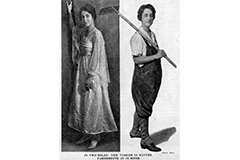
The Life of a Farmerette
Even though the federal government resisted women's efforts to create the Women's Land Army of America and work as farm laborers, women forged ahead and set up training camps in each state. After receiving training, the women, known as Farmerettes, went out to work on the farms in groups of 6-8, and were paid the same wage as men. Many of the WLAA volunteers were college-age women from elite societies in eastern US cities, so it is easy to understand how farmers might have reservations about the type of farm labor they might receive. Additionally, many of the wives of farmers were not happy about young women coming to work on their farms with their husbands.
The greatest demand for Farmerettes was in the west and the northeastern US. Tasks included milking cows, harvesting and packing fruits and vegetables, operating machinery, working with livestock, and pruning and weeding. While it did take time, farmers began to recognize and appreciate the dedication and competence of the 18,000 women laborers who served as Farmerettes during WWI.
Watch the video "Women's Land Army - History of the Farmerette" to more thoughtfully answer the questions about this event.
Questions
Describe the contributions made by the Farmerettes.
Were the reservations of the federal government and farmers justified, regarding the creation of the Women's Land Army of America? Explain.
What is the value of the WLAA to the WWI effort?


The Role of Women During WWI
During WWI, the general attitude in the US government toward the Women's Land Army of America was one of nuisance and a lack of knowing one's place in society. The Assistant Agricultural Secretary even suggested that women do the laundry for farmers and take them baked goods. With this in mind, what ideas did the government have for solving the food production problem during the war?
Here are some ideas considered by the federal government:
- using convicts as farm workers
- keeping farm workers from being drafted
- shipping POWs to the US and having them work on farms
- establishing an agricultural army from men who could not pass the physical exams and were not fit for service
- excusing high school boys from studies in the spring so they could work on farms instead
- establishing a national farm service program
Questions
Why did the government resist the willingness of women to work as farm laborers? How would that compare to a response today?
In your opinion, which of the ideas considered by the federal government was the best option? Explain.
Europe became engaged in World War I in 1914. Busy fighting, these nations struggled to feed their citizens and soldiers. The US Food Administration and the United States Department of Agriculture urged American farmers and ranchers to step up production to meet increased demand at home and abroad. Agricultural exports soared and farm prices more than doubled. This boom renewed business interest in farming, and in 1916 President Woodrow Wilson signed the Farm Credit Loan Act to provide long-term loans to farmers.
With money for expansion, farmers purchased nearly fifty thousand tractors and put forty million acres of new land into production in 1917. The war effort also saw meat production swell by more than 20 percent. The explosion of agriculture fueled a search for methods to bring more land into production. Agricultural scientists like John Widtsoe developed methods for dry farming that made it possible to grow wheat and hay in arid areas of the United States without irrigation.


Developing a Hybrid
"Developing a hybrid variety involves mixing, or crossing, the genetic materials of two or more varieties of a plant to form a new plant variety. In the first half of the 1900s, USDA scientists began trying to create hybrid varieties of corn.
"In 1906 G. H. Shull, a geneticist at Cold Spring, Harbor, N.Y., started experimenting on inheritance in corn. From his experiments came important observations on the reduction in vigor with inbreeding and the restoration of vigor with crossing which provided the basis for hybrid corn. Studies of inbreeding were made at other experiment stations also. The general opinion was that hybrid corn was not feasible because of the poor vigor of the inbred parents.
"Open-pollinated varieties are maintained by mass selection. Windborne pollen effects fertilization, and there is no control of the male parentage. Inbred lines are developed by a combination of inbreeding and selection. Inbreeding involves the transfer of pollen from an individual plant to the silks of the same plant. This process is repeated for several generations until the strain becomes stable, or true breeding. Selection is practiced in each generation to maintain only the superior types. Cross-breeding involves the crossing of selected parents. Single crosses are produced by crossing two inbred lines. Double crosses are produced by crossing two different single crosses.
"When the best of the hybrids became commercially available some farmers were reluctant to adopt them, but demonstration plantings and field observations proved the worth of the hybrids. In 1935 the demand for hybrid seed in the Corn Belt exceeded production, and the hybrid seed industry developed rapidly.
"In addition to an increase in production, other benefits have been achieved by the use of hybrid seed. For instance, hybrids make more efficient use of applied fertilizer. Progress has been made in developing hybrids resistant to some insects and diseases, and the result is a product of higher quality and more stable yearly production. Because of their greater uniformity in maturity and resistance to lodging, the hybrids have helped make large-scale mechanization possible."
Questions
How long did it take scientists to successfully create a hybrid variety of corn? Why did they want to do this?
What were the results of their efforts?
Why do you think some farmers were reluctant to use hybrid seeds?
How do farmers and consumers view the use of genetically modified seeds today?
ARS Timeline: 138 Years of Ag Research, U.S. Department of Agriculture, [online].

General John Pershing's Opinion of Farmers
The text below is a letter from General John J. Pershing, commander of all American forces in Europe, to America's Assistant Secretary of Agriculture, thanking the nation's farmers for their support in World War I.
"American Expeditionary Forces
Office of the Commander-in-Chief, France
October 16, 1918
"Honorable Carl Vrooman, Assistant Secretary of Agriculture:
"Dear Mr. Vrooman: will you please convey to farmers of America our profound appreciation of their patriotic services to the country and to the Allied armies in the field. They have furnished their full quota of fighting men[,] they have bought largely of Liberty Bonds and they have increased their production of food crops both last year and this by over a thousand million bushels above normal production. Food is of vital military necessity for us and for our Allies, and from the day of our entry into the war America's armies of food producers have rendered invaluable service to the Allied cause by supporting the soldiers at the front through their devoted and splendidly successful work in the fields and furrows at home.
"Very sincerely,
John J. Pershing."
Questions
Why did General Pershing feel so strongly about the efforts of America's farmers?
Do you think General Pershing was overdoing his praise? Why or why not?
How do you think farmers felt about receiving such recognition from General Pershing?
Francis A. March, History of the World War (Philadelphia: United Publishers of the United States and Canada, 1919).

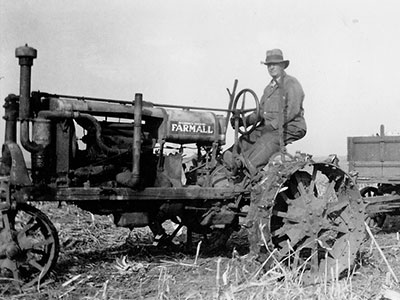
Mechanization of Farm Equipment
During the early 1900s, dramatic advances in the mechanization of farm equipment were occurring. The increased availability of farm credit during World War I enabled farmers to buy more mechanized farm machinery than ever before. Explore the history of some of the early types of mechanized farm equipment at the link below. Be sure to click on the equipment links to learn about the purpose and use of each type of equipment.
Questions
What unique role did each piece of equipment play on the farm?
What were some of the important advantages of using mechanized farm equipment over horse-powered equipment? What may have been some of the disadvantages?
Why might it be difficult for farmers then and now to upgrade to new equipment and technology for their farms?

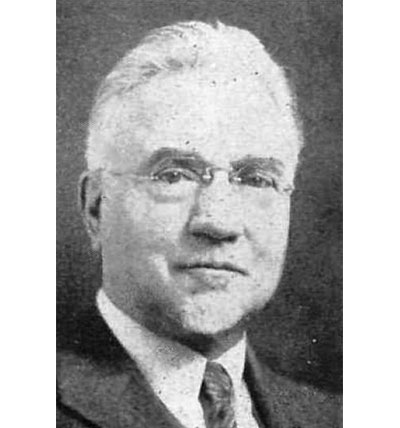
Dry-farming in a Nutshell
Farming in the western territories called not only for new equipment but also for new techniques. The dry climates of the West meant that either soils had to be irrigated or dry-farming methods applied. Read this excerpt from chapter 20 of Dry-Farming: A System of Agriculture for Countries under Low Rainfall.
"Dry Farming in a Nutshell
"Locate the dry-farm in a section with an annual precipitation of more than ten inches and, if possible, with small wind movement. One man with four horses and plenty of machinery cannot handle more than from 160 to 200 acres. Farm fewer acres and farm them better.
"Select a clay loam soil. Other soils may be equally productive, but are cultivated properly with somewhat more difficulty.
"Make sure, with the help of the soil auger, that the soil is of uniform structure to a depth of at least eight feet. If streaks of loose gravel or layers of hardpan are near the surface, water may be lost to the plant roots.
"After the land has been cleared and broken let it lie fallow with clean cultivation, for one year. The increase in the first and later crops will pay for the waiting.
"Always plow the land early in the fall, unless abundant experience shows that fall plowing is an unwise practice in the locality. Always plow deeply unless the subsoil is infertile, in which case plow a little deeper each year until eight or ten inches are reached. Plow at least once for each crop. Spring plowing if practiced, should be done as early as possible in the season.
"Follow the plow, whether in the fall or spring, with the disk and that with the smoothing harrow, if crops are to be sown soon afterward. If the land plowed in the fall is to lie fallow for the winter, leave it in the rough condition, except in localities where there is little or no snow and the winter temperature is high.
"Always disk the land in early spring, to prevent evaporation. Follow the disk with the harrow. Harrow, or in some other way stir the surface of the soil after every rain. If crops are on the land, harrow as long as the plants will stand it. If hoed crops, like corn or potatoes, are grown, use the cultivator throughout the season. A deep mulch or dry soil should cover the land as far as possible throughout the summer. Immediately after harvest disk the soil thoroughly.
"Destroy weeds as soon as they show themselves. A weedy dry-farm is doomed to failure.
"Give the land an occasional rest, that is, a clean summer fallow. Under a rainfall of less than fifteen inches, the land should be summer fallowed every other year[,] under an annual rainfall of fifteen to twenty inches, the summer fallow should occur every third or fourth year. Where the rainfall comes chiefly in the summer, the summer fallow is less important in ordinary years than where the summers are dry and the winters wet. Only an absolutely clean fallow should be permitted.
"The fertility of dry-farm soils must be maintained. Return the manure plow under green leguminous crops occasionally and practice rotation. On fertile soils plants mature with the least water.
"Sow only by the drill method. Wherever possible use fall varieties of crops. Plant deeply--three or four inches for grain. Plant early in the fall, especially if the land has been summer fallowed. Use only about one half as much seed as is recommended for humid-farming.
"All the ordinary crops may be grown by dry-farming. Secure seed that has been raised on dry-farms. Look out for new varieties, especially adapted for dry-farming, that may be brought in. Wheat is king in dry-farming[,] corn a close second. Turkey wheat promises the best.
"Stock the dry-farm with the best modern machinery. Dry-farming is possible only because of the modern plow, the disk, the drill seeder, the harvester, the header, and the thresher.
"Make a home on the dry-farm. Store the floodwaters in a reservoir or pump the underground waters, for irrigating the family garden. Set out trees, plant flowers, and keep some livestock.
"Learn to understand the reasons back of the principles of dry-farming, apply the knowledge vigorously, and the crop cannot fail.
"Always farm as if a year of drouth [drought] were coming."
Questions
How does the technique of dry farming impact the economies of the western states?
Why is this book on dry farming still used by farmers around the world today?
John A. Widtsoe, Dry-Farming: A System of Agriculture for Countries under Low Rainfall [online].

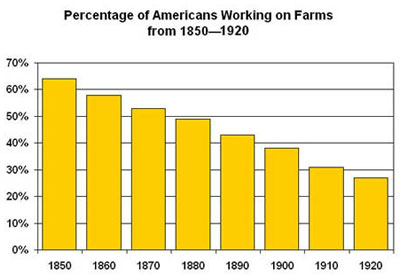
Percentage of Americans Working on Farms from 1850-1920
This chart shows the decline in the number of farm workers from 1850 to 1920.
Questions
Why do you think these changes occurred?
What do the changes tell us about technological advances?
How do you think these changes affected American communities during this period?
History of American Agriculture, 1607-2000, U.S. Department of Agriculture [online].
In the early 1900s many communities were looking at how to improve farming and farm life. The Binghamton Chamber of Commerce suggested a demonstration farm be established, but that idea was not widely embraced. The second idea was to employ a “county agricultural expert” similar to the “county demonstrators” in the southern states. That idea stuck. The Chamber of Commerce, USDA and Lackawanna Railroad all contributed funds to make this happen. On March 20, 1911, John Barron, a graduate of Cornell was hired to work with the farmers in the area. He was officially employed by the Chamber of Commerce in their newly created “Farm Bureau.”
Soon counties across the country were establishing local “Farm Bureaus” for the purpose of conducting agricultural extension work at the local level. The process and procedures varied greatly from state to state. In the northern and western states the local organizing group was typically called the County Farm Bureau.
https://footnote.wordpress.ncsu.edu/2019/10/11/celebrating-100-years-of-the-american-farm-bureau-federation-part-i-10-11-2019/

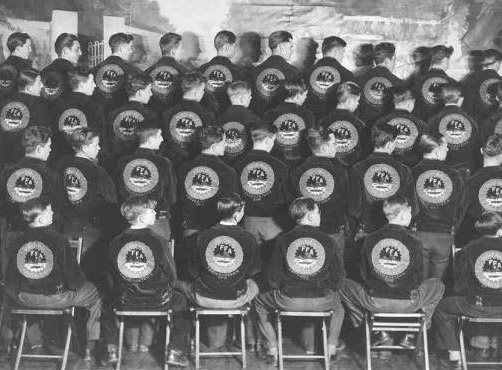
Future Farmers of America
In 1928, 33 students from 18 states gathered in Kansas City, Mo., to form the Future Farmers of America. The organization was developed at a time when boys were losing interest and leaving the farm.
Improved farm technologies and mechanization in the 20th century resulted in greater yields and lower commodity prices. Many left rural areas to pursue employment in the cities. Farmers, educators, and policymakers became concerned about the numbers of those remaining on farms and “city folk” that might forget about where their food and fiber was produced. As a result, corn and tomato growing clubs, which evolved into additional 4-H agricultural clubs (4-H History, 2019), emerged. Some of these concerned educators with the support of agricultural organizations began a campaign to include agriculture as an occupational specialty that, at the very least, should be taught as a vocation in secondary schools. This movement resulted in the development of “vocational” or secondary school-based agricultural education programs (1917) and the Future Farmers of America (1928).
Girls were admitted into the organization in 1969. The name Future Farmers of America was changed to FFA Organization in 1988 to be more inclusive of those who sought a future in agriculture outside of production agriculture in supportive agriscience and agribusiness "future" careers.
Visit the FFA history timeline learn more about why the FFA program is part of public education.
Questions
How did the Smith-Hughes Act of 1917 influence the development of agricultural education and FFA in public high schools?
In 1935 the New Farmers of America (NFA) was founded in Tuskegee, AL. The African American farm youth organization had over 100,000 members. In what year did NFA merge with the FFA? What legislation influenced this union?


Farm Bureau Federation - The Voice of Agriculture
A number of state farm bureau federations were organized after 1915. Farm bureaus engaged in rural education or extension work for more improved crops and livestock. Women members formed groups inclusive of home economics. In 1919 there was a movement to establish a national farm bureau federation. Thirty-four states met in Chicago on November 12, 1919 and the American Farm Bureau Federation was officially established.
To learn more view the American Farm Bureau Federation Centennial video.
Questions
What examples from the video support the American Farm Bureau tagline as "The Voice of Agriculture?"
Use the Growing a Nation timeline to compare and contrast the American Farm Bureau Federation, the Grange, Cooperative Extension, FFA, 4-H, the National Farmers Union. What if any relationships are there after 100 years?
How relevant or powerful is the American Farm Bureau Federation today?
Image Source: American Farm Bureau


National Farmers Union
NFU was founded by ten family farmers in 1902 as the Farmers Educational Cooperative Union of America in Point, Texas. The organization "advocated for increased co-operative rights, fair market access for farmers, direct election of senators and voting rights for women." The National Farmers Union focus was the profitability of family farms and supported the development of cooperatives.
Today the vision of the NFU is " A world in which farm families and their communities are respected, valued, and enjoy economic prosperity and social justice." And the mission is to " Advocate for family farmers, ranchers, fishers, and their communities through education, cooperation, and legislation."
Questions
Compare and contrast the National Farmers Union and discuss which one you would join if you were a farmer.
https://nfu.org/about/


Despite recent wartime plenty, during the 1920s the quality of life for many rural households was far lower than for city families. Forty percent of rural homes lacked indoor plumbing or electricity, and many farmers began to envy city life.
As Europe recovered from the world war, the wartime market disappeared and created a surplus of products and plummeting prices. Many agricultural producers could not make the payments on loans they had taken out for machinery, land, and seed during the war, and banks began to foreclose on them. A nationwide agricultural depression set in. Over one million farmers had to seek employment in the cities.
Unfortunately, the agricultural depression of the 1920s was only the beginning of the Great Depression, a national crisis that would affect all Americans for another decade to come.
Despite recent wartime plenty, during the 1920s the quality of life for many rural households was far lower than for city families. Forty percent of rural homes lacked indoor plumbing or electricity, and many farmers began to envy city life.

American Nutrition Becomes a Science
During the 1920s, the government became concerned about the nutrition of Americans. Watch the attached silent film produced by USDA to learn more about the science of nutrition.
Questions
How do the nutrition problems of the 1920s compare with those of today?
Based on the timing of this film, what do you think was the motivation for the government to encourage healthy eating?
How does better nutrition help Americans?
Film Food Makes a Difference, 1931, courtesy of U.S. National Archives and Records Administration.

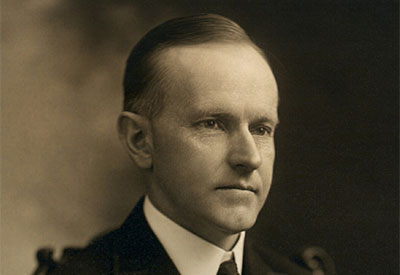
Calvin Coolidge
President Calvin Coolidge served from 1923 to 1929.
"To many Americans, Calvin Coolidge embodied the frugality they sought in their lives. The image he presented in numerous photographs and films was that of a simple man who endorsed plain living. Pictures of him as a rural Vermonter working in the fields of his family's Plymouth Notch farm emphasized traditional values and thriftiness and allayed popular anxieties about excess and indulgence. It was an image that served him well and that he actively promoted in his electoral and public-relations campaigns.
"In keeping with his image, Coolidge's great policy concern was economy in government. He assumed office in August 1923 upon the death of Warren G. Harding and served as president for six years. During that time he concerned himself with such measures as paying off the national debt, eliminating waste, and cutting taxes to stimulate capital investment. He also endorsed a business climate in which advertising played a major role. He generally spoke and acted in ways that supported business regardless of his private opinions, and viewed the federal government itself as a cost-conscious business organization."
Questions
Why have many presidents, like Coolidge, emphasized their rural roots?
Is it the responsibility of government to see that the economy prospers? Why or why not?
"The Coolidge Presidency," Library of Congress [online].


Dr. Louise Stanley
Dr. Louise Stanley, first chief of the Bureau of Home Economics.
The USDA formed the Bureau of Home Economics in 1923. Dr. Louise Stanley served as the first chief of the bureau. She had previously served as chairman of the Home Economics Division at the University of Missouri.
During her time at the Bureau of Home Economics, Dr. Stanley worked to apply scientific solutions to the day-to-day problems facing rural families. She is noted for her scientific analyses of nutrition and for developing recommendations for healthy diets. Dr. Stanley studied the nutritional needs of Americans during times of disaster, and also compiled estimates of the foods Americans needed in order to have an adequate diet.
Questions
How is science used today to solve everyday problems?
What aspects of your life are influenced by scientific research?
The Yearbook of Agriculture, 1962 (Washington, D.C.: U.S. Department of Agriculture, 1962).
As Europe recovered from the world war, the wartime market disappeared and created a surplus of products and plummeting prices. Many agricultural producers could not make the payments on loans they had taken out for machinery, land, and seed during the war, and banks began to foreclose on them. A nationwide agricultural depression set in. Over one million farmers had to seek employment in the cities. Unfortunately, the agricultural depression of the 1920s was only the beginning of the Great Depression, a national crisis that would affect all Americans for another decade to come.


Mechanized Agriculture
Modern machinery had made wheat farming more efficient and profitable. The result was more land speculation, more acreage turned over to wheat farming, and a blind faith that the good times wouldn't end. But warning signs were evident. View this Mechanized Agriculture video from the Ken Burns in the Classroom collection to answer the following question.
Questions
How did the mechanization and industrialization of agriculture in the Great Plains contribute to the Dust Bowl?

Copied url to clipboard!



